When I found GuruShots, I thought I'd gone to heaven. This was 500px and ViewBug on speed and with the added bonus of me, for a long time, apparently enjoying lots of success.
Like ViewBug, GuruShots is all about contests, or "challenges" as they call it. You submit up to four images to challenges such as "Single Tree", "Two Wheels", or "Minimalism". Then, in order for your images to receive exposure and thereby votes, GuruShots wisely requires that you participate in the voting process. In other words, your only way to success is to vote on everybody else's images every day for the two weeks most contests last.
As your own images - hopefully - receive votes from other contestants, you move up in the hierarchy from "Popular" to "Skilled" to "Premier" to "Elite" and finally "All Star". Along the way, you can swap your photos if they don't perform as well as you hoped. When you sign up for GuruShots, and after every other contest you participate in, you receive free swaps, but if you need more than that, swaps can also be purchased.
There are several other twists to the challenges, but the gist of it is that, unlike ViewBug contests, GuruShots contests are fast and very immediate, and unlike 500px, you can truly influence how much your pictures are exposed. If you do quality work and you keep voting, you will most likely fare well. At least, that's what it looks like at first glance, and to some degree, it's probably true.
However, GuruShots is not without flaws. After participating in numerous contests, I'm starting to notice strange patterns that make me question the fairness of it all. First of all, GuruShots is free to use. You don't have to spend a dime if you don't want to. That's all well and good, but... how, then, does GuruShots make money? As I mentioned earlier, they sell swaps. So, it is very much in GuruShots' interest that you buy these swaps, and what I'm noticing is that swapping images almost always pays off. I have swapped images maybe 50 times, and I can only remember a couple of times when the new image I swapped to didn't receive more votes than the one it replaced. So the pattern is unmistakable: for the user, swapping equals more votes - for GuruShots, swapping equals more money. Everybody wins. The question is, do GuruShots' algorithms somehow favor swapping?
Another questionable premise about GuruShots is that as you move up in the hierarchy, you get more voting power. When a "Newbie" votes for your photo, you get 1 point, a "Rookie" vote is worth 2 points, a "Challenger" 3 points, etc. But nowhere in GuruShot's rules and FAQ's does it say whether image exposure is evenly distributed among the various ranks. This can make a huge difference in how many points your images receive.
Altogether, there are just too many things - and I could come up with several more examples - that leave you wondering whether GuruShots really is as fair as it seems at first glance. Even though I have used and loved GuruShots every day for more than six months, I'm at a point now where I don't feel it's worth my time anymore. Another major factor in that decision is that I have hit a wall when it comes to my own climb up the hierarchy ladder. I'm currently at the "Expert" level. It didn't take me all that long to reach that, but in order to advance to the next level - "Champion" - I need to finish in the top 10% in at least one contest and have an image picked by the person who launched the contest (the "Guru"). Both of those requirements have turned out to be seemingly impossible. It doesn't matter how much my pictures have improved - and I believe I have made tons of progress since I signed up for GuruShots - I do absolutely no better in contests than I did when I started. On the contrary, algorithms have changed and made it quite a bit harder to fare well. That, and I no longer wish to spend money on buying swaps, which, as stated above, is important in order to achieve success.
So, although I imagine I might return now and then to test if my odds have improved, in the foreseeable future I will probably turn my focus back to ViewBug for contests. Sure, GuruShots is a wonderful playground at first. There is a lot more instant gratification than on any other site I have tried, and sure, it can be a reasonably good test for your images. In the end, however, once you get used to the pace and the shower of votes you sometimes receive, the nagging questions about what's really going on under the hood become too hard to ignore. That is, of course, unless you are so undeniably great that you manage to break through to the highest levels without any fuss.
Apparently, I'm not that.
Below are two of my more successful images on GuruShots. It's impossible to say exactly what images have fared the best. All they tell you is if an image ended up in the top 10%, 20% or whatever, and how many points they scored across all of the contests they were submitted to.
As of today KSA Gallery will be known as Plain Exposure. I was never too happy with KSA Gallery. Not sure why. I wanted something a little "cooler" and perhaps more ambiguous.
The site also got a new sub-title: "The Life and Struggles of an Amateur Photographer". Of course, it's somewhat ironic. Mostly life as an amateur photographer is quite rewarding, but much of what I write about - and will be writing about in the future - is the struggling with everything from lack of self-confidence to unfair algorithms on social media.
But most of all, now as in the past, this site is just a way for me to put my images out there for everyone to see. In other words... plain exposure.
Bruce Springsteen once said that as a young, unknown rock band you need to both think you are the greatest thing in music since the Beatles... and that you suck. The former gives you the confidence and attitude to maybe make others believe it too, and the latter makes you work harder at actually getting better.
This is not unlike how I feel as a photographer. In my own mind I am among the world's most underrated photo artists, but most external evidence tells me that I'm just another mediocre face in the ever growing mass of mediocre middle aged men with expensive cameras resting on their pot bellies.
When I look at my pictures from maybe just a year ago, I can see that the evidence was accurate: most of the pictures I thought back then were masterpieces, I now realize were nothing special and that the world's indifference to them was quite reasonable. On the other hand, the pictures I took today are mind blowing and will finally give me the recognition I deserve.
But then fear strikes me. What if in a year from now I can see that the pictures I now think are mind blowing are just as unremarkable as my old pictures? What if my pictures are not improving at all? What if the only thing that's improving is my state of denial?
As an amateur photographer, you don't have very many solid indicators to tell you if you're getting better. You can't measure it by sales since you're not selling. Friends and family may just tell you what you want to hear. And your own gut feeling and tastes prove worthless as images you wouldn't be caught dead having taken receive more votes/likes/awards than yours on GuruShots/Instagram/ViewBug.
Whatever the case, as of right now, in the confines of my own deluded, self-absorbed brain, I believe that the last couple of months have produced some of my best images ever. I have not written about it due to being busy tired, but November and December have been very productive in both quantity and quality with several photo outings, each of which brought forth sure additions to my portfolio should I one day get around to updating it.
Since I may still write more extensively about those outings, I will only post a few of the best shots here. The first two images are from the same day in November, a day that was split in two with the first half spent at the beautiful Bøllemose area with a low sun creating magical light between the trees, and the second half on the coast, including a blue hour to die for at a nearby marina. 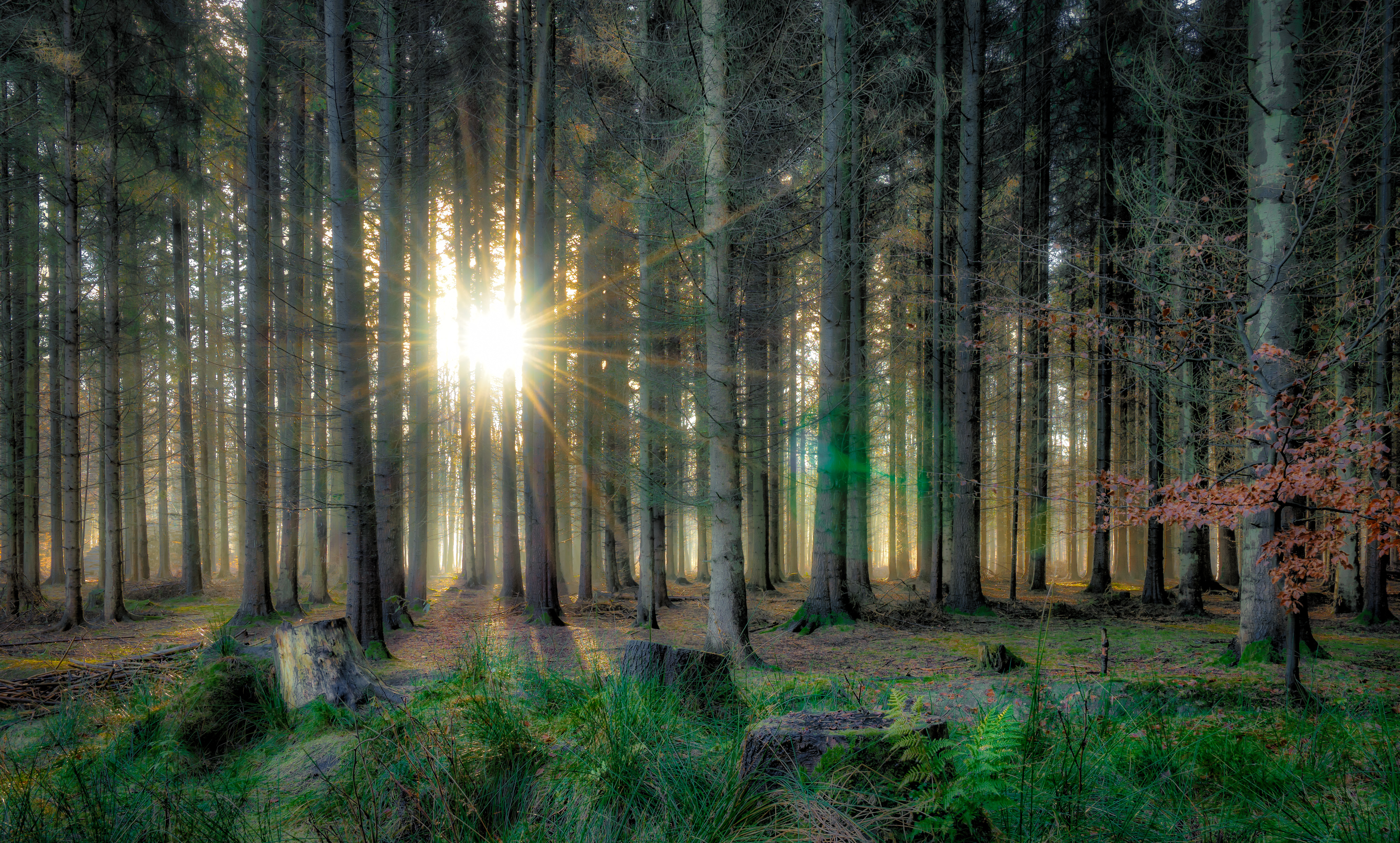
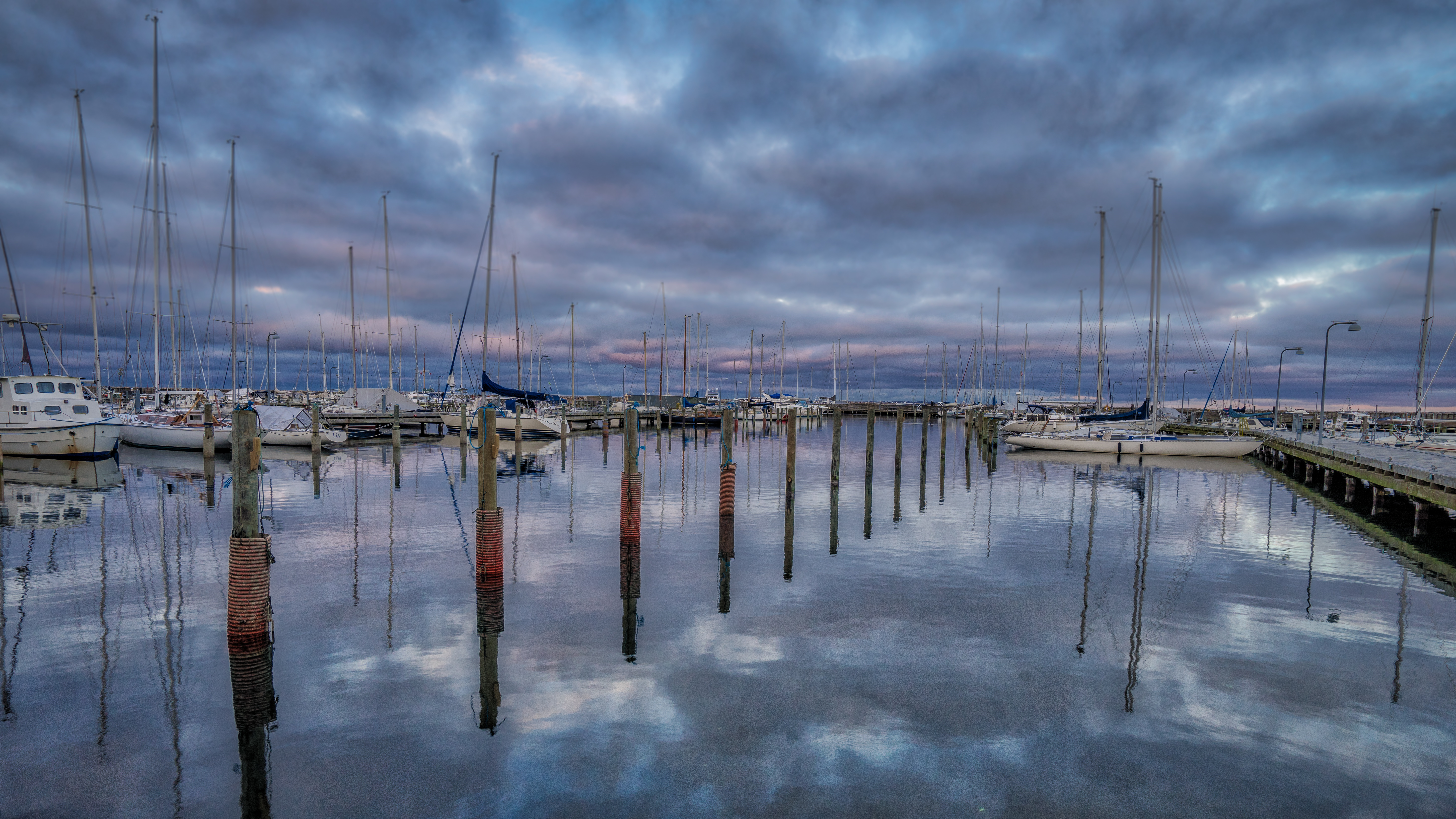 The next image is from my local area where, one Sunday afternoon, I spent the hours around the early Scandinavian sunset on a rugged, muddy field, almost ruining my boots, but capturing some pictures that I was really happy with., including this one.
The next image is from my local area where, one Sunday afternoon, I spent the hours around the early Scandinavian sunset on a rugged, muddy field, almost ruining my boots, but capturing some pictures that I was really happy with., including this one.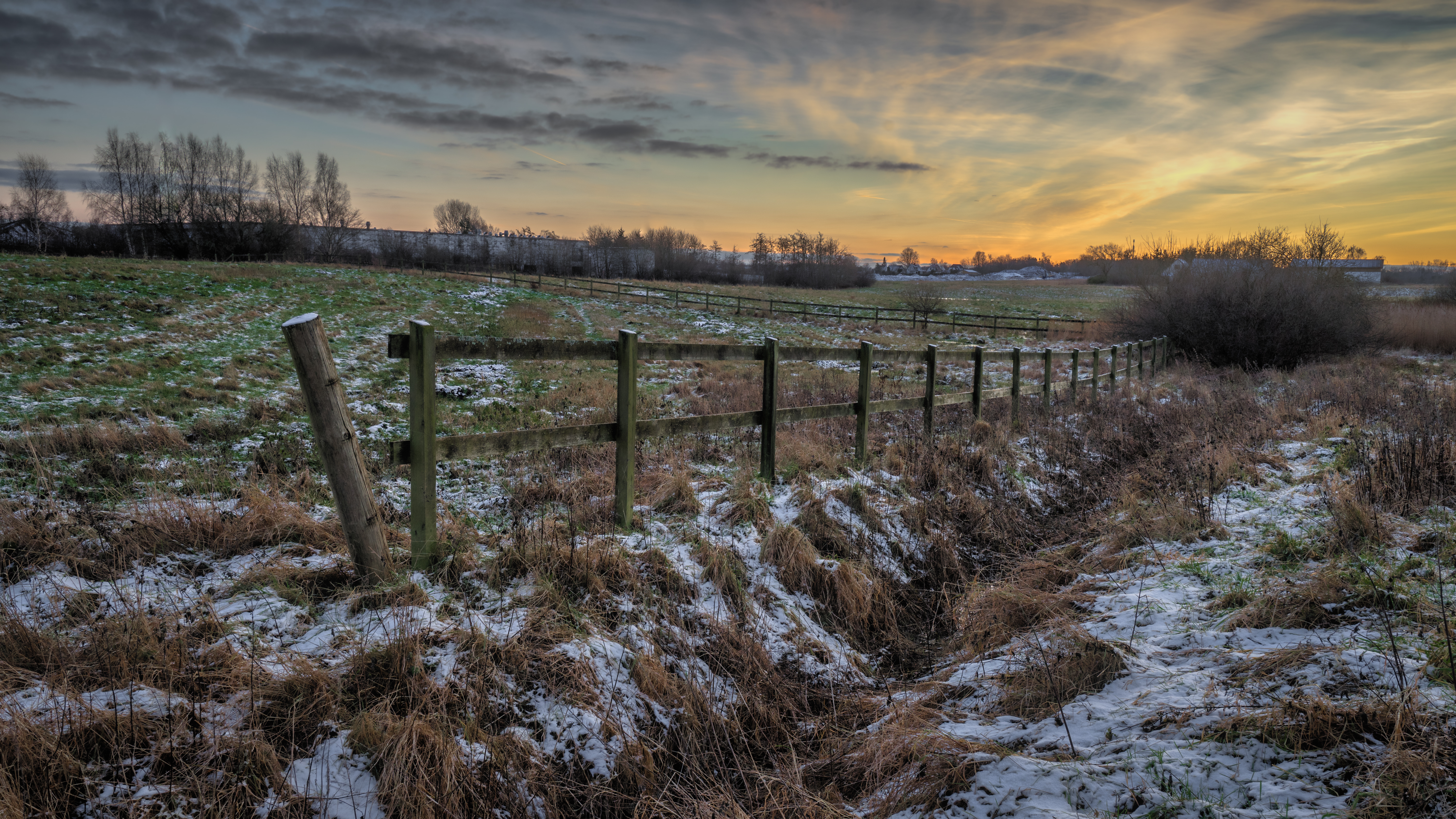 Also from my local area is the below picture of the weirdly curved tree on the edge of the forest. I absolutely love the colors and composition in this one.
Also from my local area is the below picture of the weirdly curved tree on the edge of the forest. I absolutely love the colors and composition in this one. 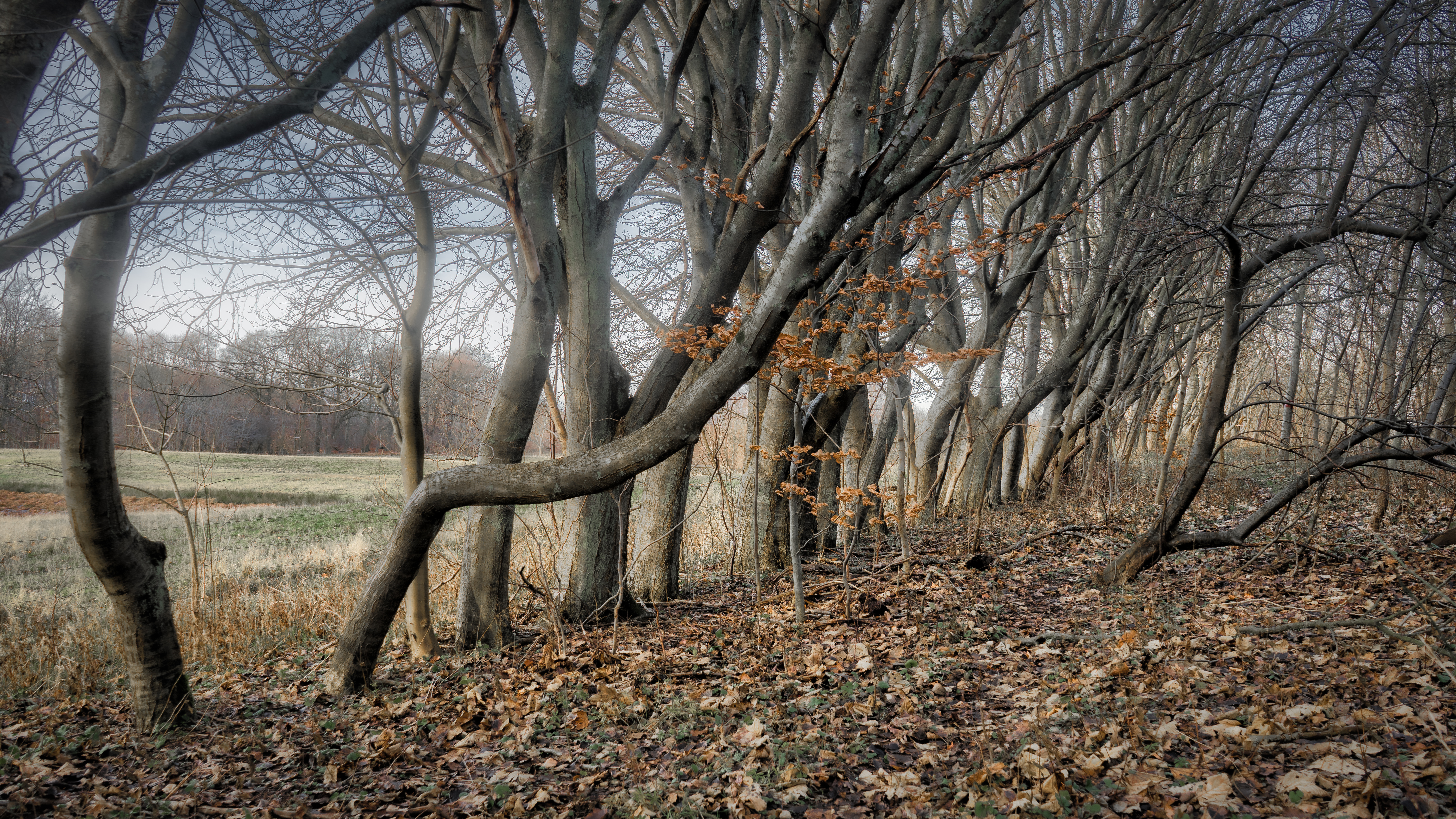 Last but not least, from a trip into Copenhagen and beyond, this image was taken at a part of the city called Ørestad, which has only existed in the past 10 years or so. The picture of a train leaving the station was very nicely captured, in my own opinion, with the exposure length at a perfect 0.6 seconds, which added juuust the right amount of blur... again, in my own opinion.
Last but not least, from a trip into Copenhagen and beyond, this image was taken at a part of the city called Ørestad, which has only existed in the past 10 years or so. The picture of a train leaving the station was very nicely captured, in my own opinion, with the exposure length at a perfect 0.6 seconds, which added juuust the right amount of blur... again, in my own opinion.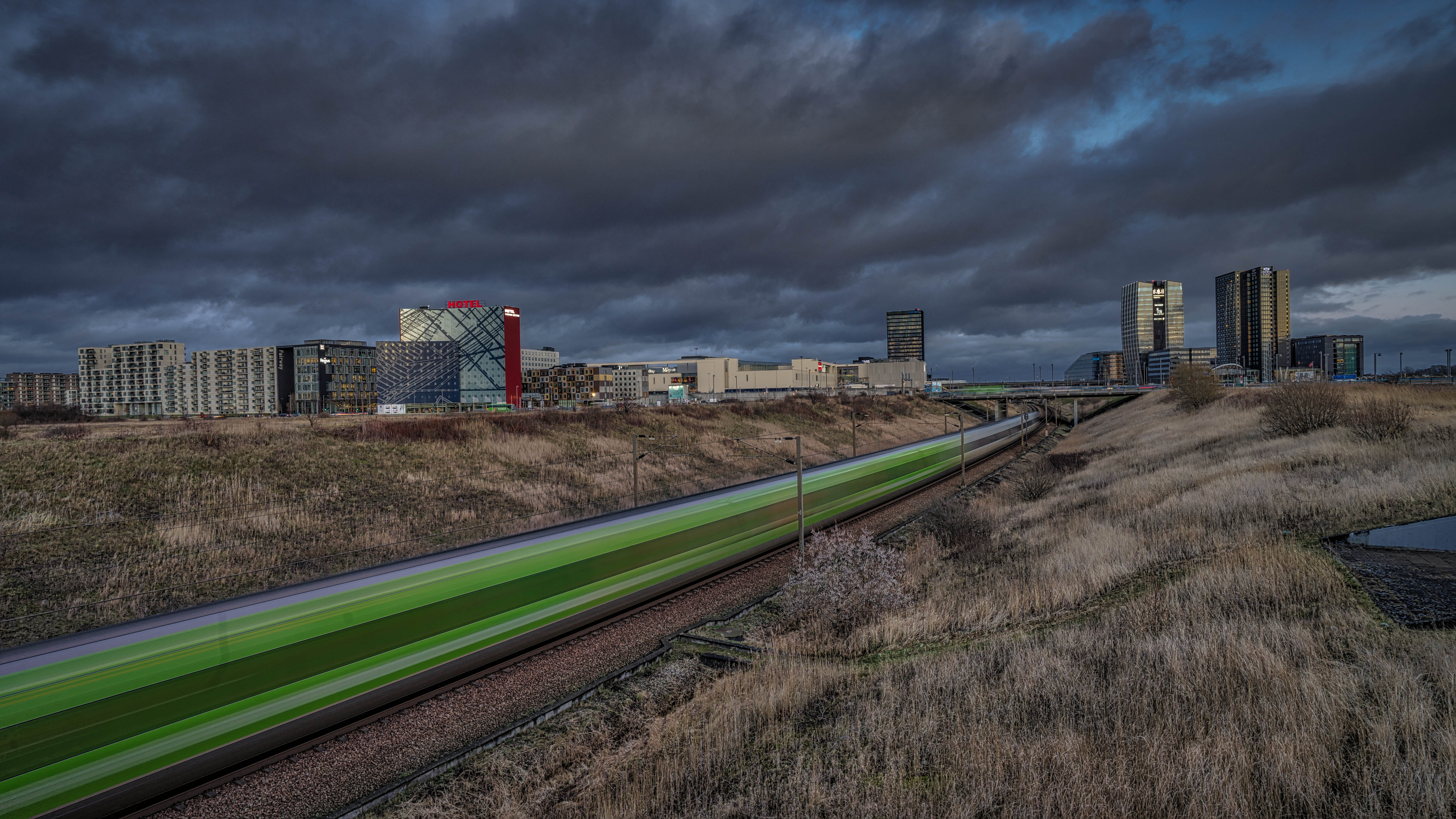 I took several more top-notch pictures on all of those trips, but they will have to wait. These are just examples of what I've been up to in the last few months and hopefully a little bit of evidence that both my mastering of my camera and my ability to capture the beauty I encounter have indeed improved.
I took several more top-notch pictures on all of those trips, but they will have to wait. These are just examples of what I've been up to in the last few months and hopefully a little bit of evidence that both my mastering of my camera and my ability to capture the beauty I encounter have indeed improved.
I guess we'll see in a year from now.
Back in July I wrote about the time of year when the beautiful, bright leaves of the beech trees light up the forest and make your shutter finger itch. If there is a time of the year that is as important for photographers here in Denmark as those weeks in May, it would be October and November when those same trees explode in orange and yellow colors.
Fortunately, I recently had the opportunity to visit the ultimate location in the area for fall photography, the stunning nature resort Dyrehaven just 30 minutes from downtown Copenhagen. Dyrehaven is a combination of forest and open plain. It is not a huge area. You can walk through it in an hour or so (unless you stop every two minutes to take pictures, in which case it takes three), but due to some kind of government or city decree, no one is allowed to build houses that stick up above the tree line when you stand on the big hill in the center. In other words, it feels like an isolated natural reserve, and it's easy to forget how close you are to the city.
The only problem on this day was the light. The sky was gray and dreary, but the clouds were still well-defined and therefore things could have been much worse. I certainly preferred this to a clear blue sky.
First we have the entrance gate to the area. It is in itself a beautiful structure, and with the fall leaves framing it, it just lends itself to photography.  The next image is the only one in the bunch taken with my cell phone. I always snap a few images with my cell phone when I'm on a photo shoot. just to have some for my Instagram and just because cell phone images have a different flavor that sometimes make a nice addition to my collection, as was the case with this one. None of my shots taken with my real camera captured the way the leaves formed a low ceiling over the leaf-covered forest floor quite as well.
The next image is the only one in the bunch taken with my cell phone. I always snap a few images with my cell phone when I'm on a photo shoot. just to have some for my Instagram and just because cell phone images have a different flavor that sometimes make a nice addition to my collection, as was the case with this one. None of my shots taken with my real camera captured the way the leaves formed a low ceiling over the leaf-covered forest floor quite as well.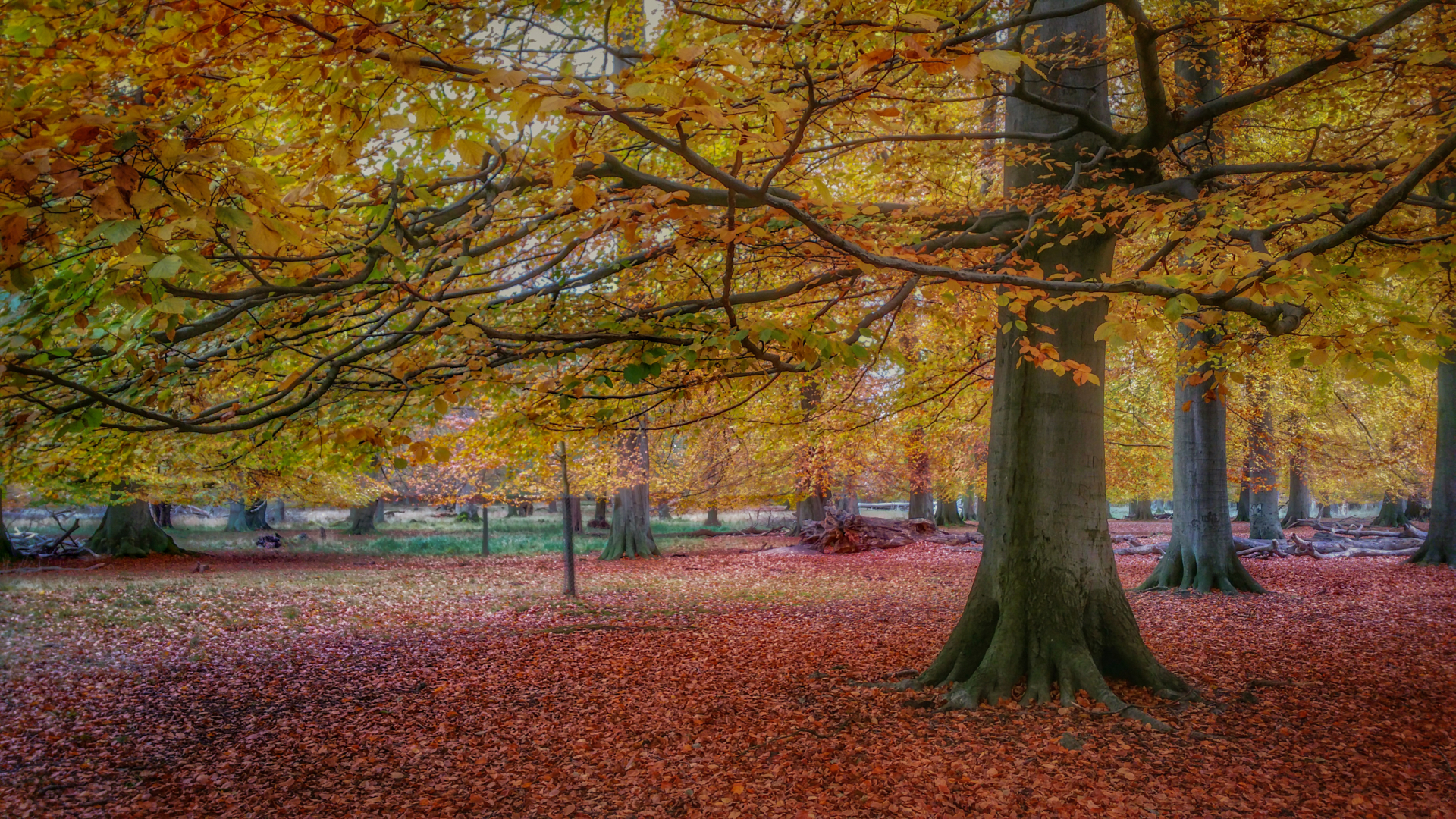 Moving on, the forest was replaced by more open landscape interspersed with awesome old orange-leafed trees that begged to be photographed. I especially liked this old oak tree - or whatever it is. And no, this would not have worked with a clear blue sky as the background. Old, crooked trees require gloomy, gray clouds.
Moving on, the forest was replaced by more open landscape interspersed with awesome old orange-leafed trees that begged to be photographed. I especially liked this old oak tree - or whatever it is. And no, this would not have worked with a clear blue sky as the background. Old, crooked trees require gloomy, gray clouds.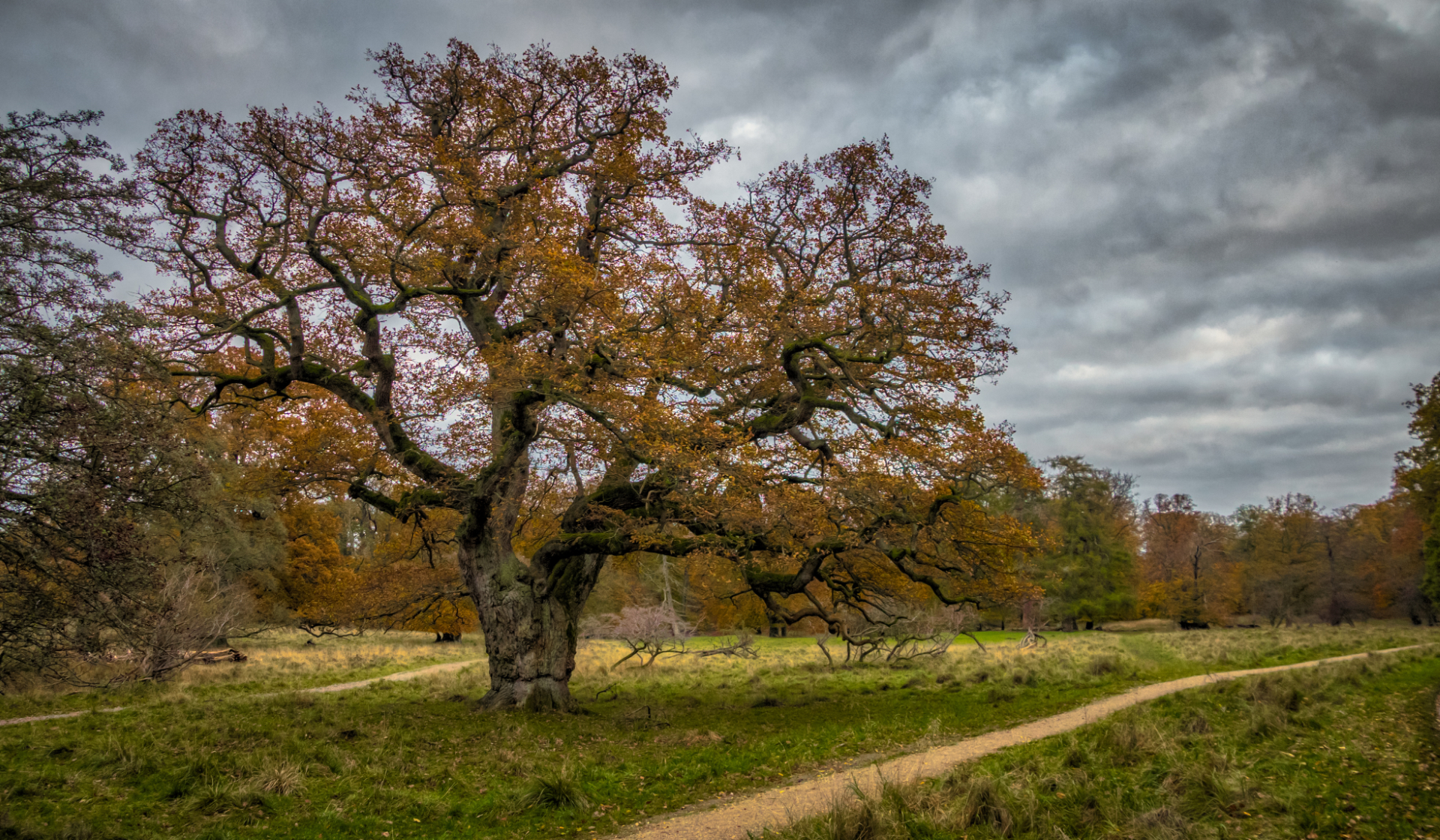 As I continued up the hill in the center of Dyrehaven, I came across the pond shown below with a swan couple floating around. At this point the sun was setting and the sky had started to break up a little bit, showing some blue and purple colors. I spent quite some time there, shooting the pond from all kinds of angles. And waiting for the swans to not be grooming their feathers and not sticking their heads into the water looking for food. They do that a lot, and it's not how you want to see swans in photos. You want them with those beautiful, curved necks held high or, as in this case, with their wings spread in an angel pose.
As I continued up the hill in the center of Dyrehaven, I came across the pond shown below with a swan couple floating around. At this point the sun was setting and the sky had started to break up a little bit, showing some blue and purple colors. I spent quite some time there, shooting the pond from all kinds of angles. And waiting for the swans to not be grooming their feathers and not sticking their heads into the water looking for food. They do that a lot, and it's not how you want to see swans in photos. You want them with those beautiful, curved necks held high or, as in this case, with their wings spread in an angel pose.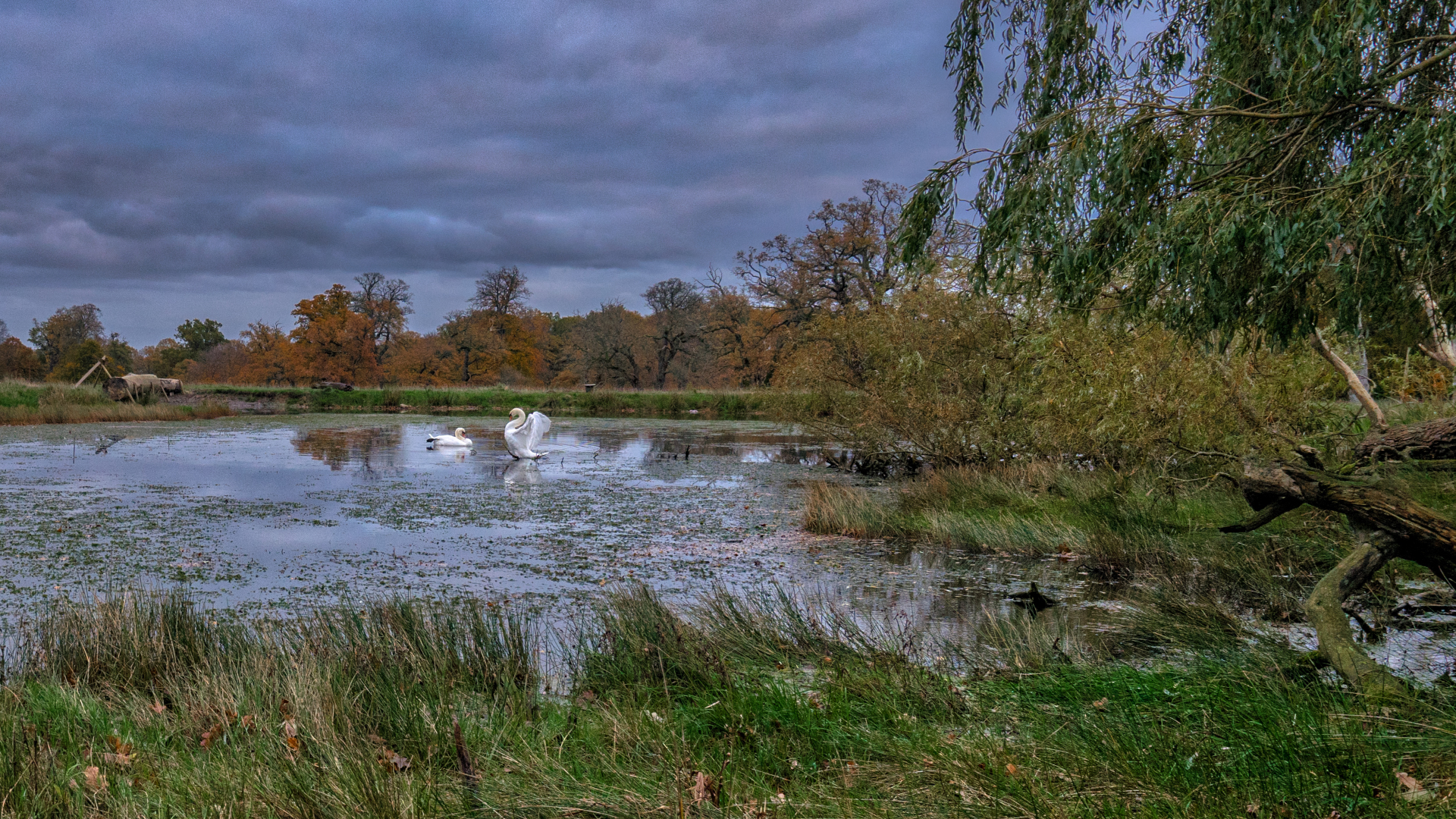 At the very top of the hill, there is a tiny castle called the Hermitage Hunting Lodge or, in Danish, Eremitageslottet. Dyrehaven is also referred to as the Hermitage and used to be a royal hunting ground. Every year a horse race with riders in traditional red hunting coats takes place. They don't hunt anything other than a victory in the race, although more modern hunting (thankfully without horses or dog packs) does happen in order to control the number of game.
At the very top of the hill, there is a tiny castle called the Hermitage Hunting Lodge or, in Danish, Eremitageslottet. Dyrehaven is also referred to as the Hermitage and used to be a royal hunting ground. Every year a horse race with riders in traditional red hunting coats takes place. They don't hunt anything other than a victory in the race, although more modern hunting (thankfully without horses or dog packs) does happen in order to control the number of game.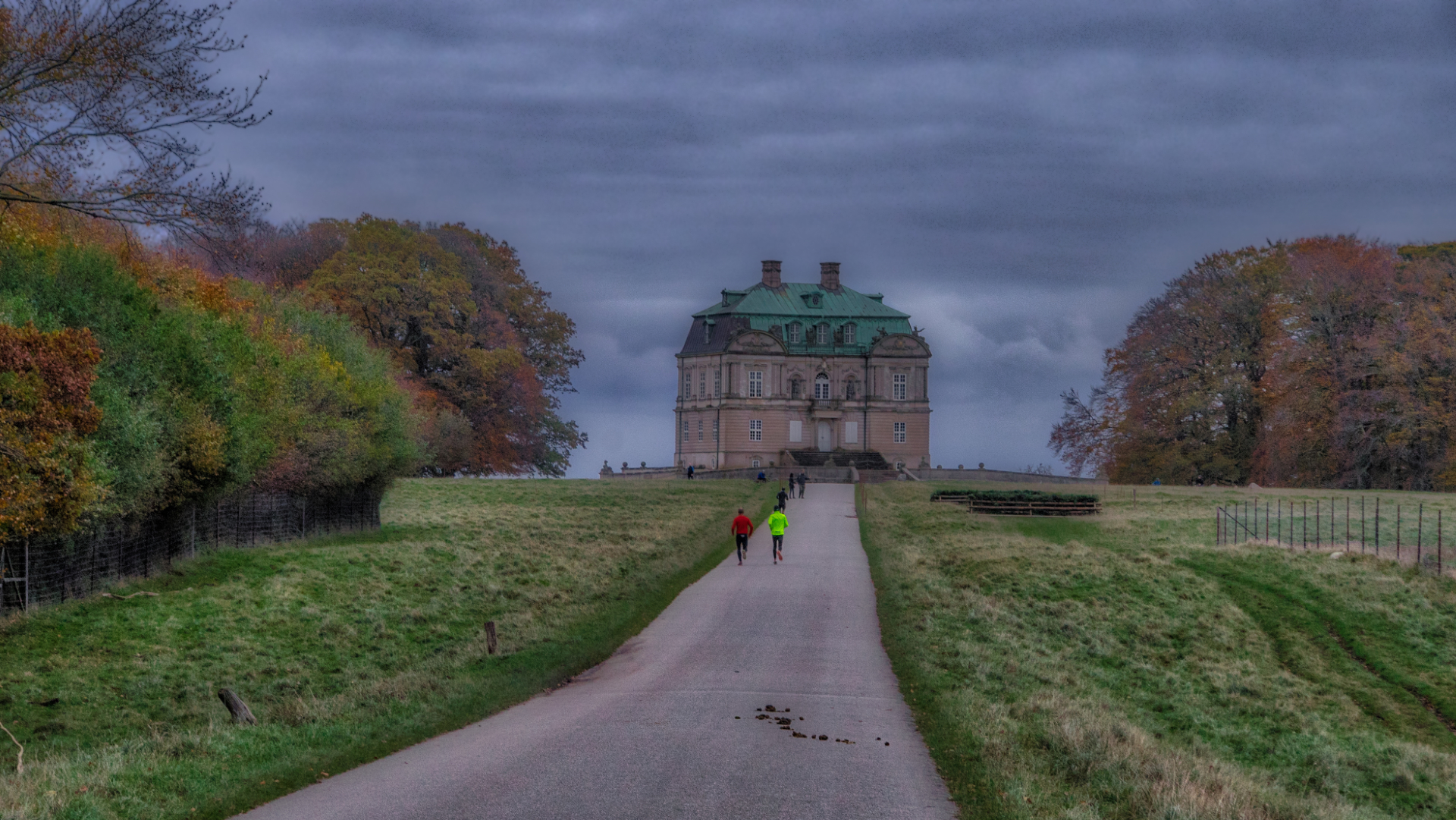 That brings me to one of the absolute coolest features of Dyrehaven: deer. The place is full of them, in all shapes and sizes. You cannot avoid seeing them if you tried. I had taken a few pictures of a herd of deer earlier in the day, but it wasn't until I was headed for the park exit that I got close enough for something like the image shown below. Unfortunately, it was getting dark at this point, forcing me to use an extremely high ISO of 6000+ in order to get any sharpness at all. Still, several images, including this one, turned out quite well, which speaks for my Sony camera's noise-reduction capabilities... as well as Lightroom's.
That brings me to one of the absolute coolest features of Dyrehaven: deer. The place is full of them, in all shapes and sizes. You cannot avoid seeing them if you tried. I had taken a few pictures of a herd of deer earlier in the day, but it wasn't until I was headed for the park exit that I got close enough for something like the image shown below. Unfortunately, it was getting dark at this point, forcing me to use an extremely high ISO of 6000+ in order to get any sharpness at all. Still, several images, including this one, turned out quite well, which speaks for my Sony camera's noise-reduction capabilities... as well as Lightroom's.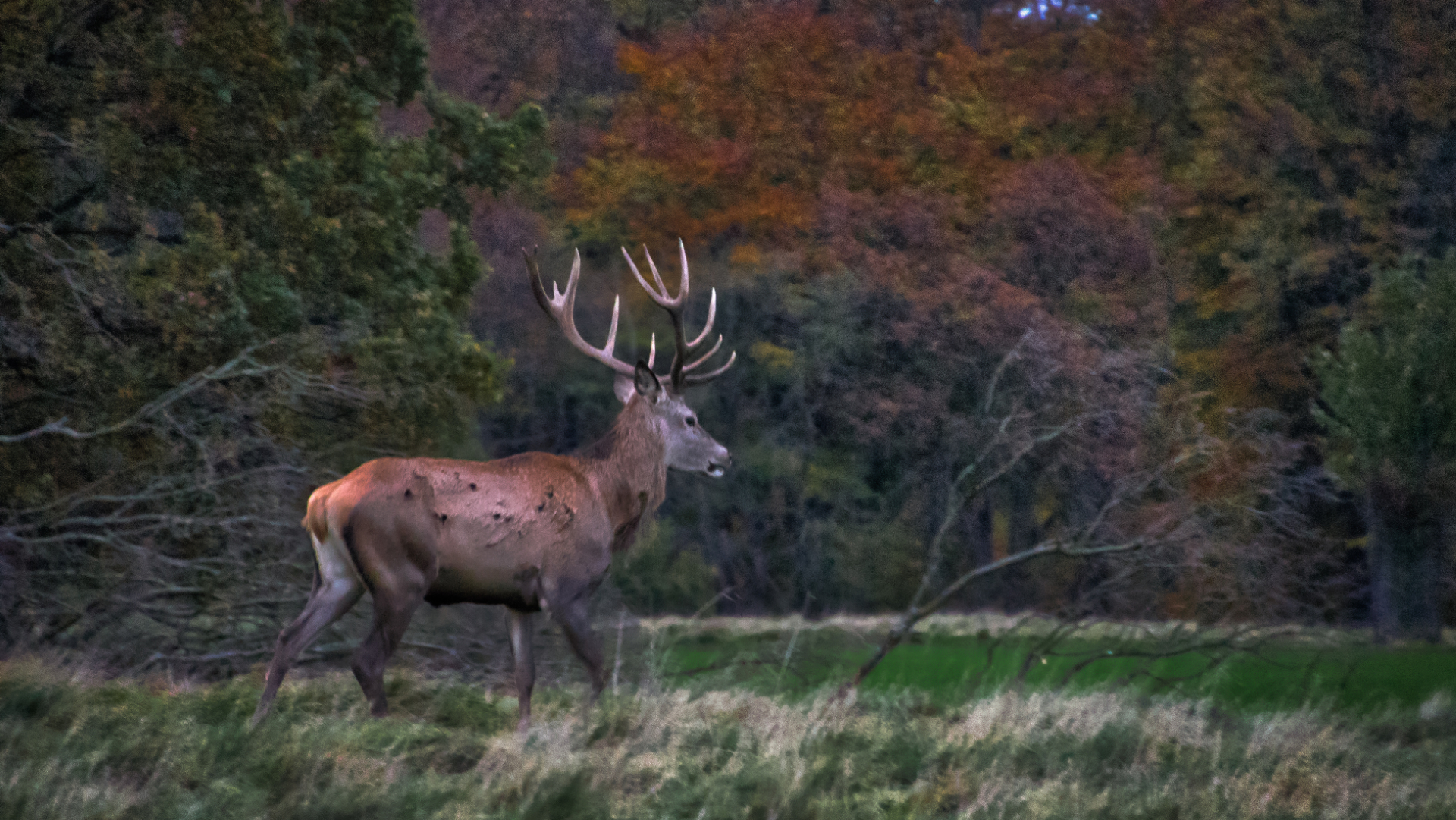 Darkness had now fallen and it was time to head out. I'd enjoyed several hours of the most exquisite nature and landscape you will find that close to a big city. Given that it was a week day and late in the year, I felt like it had been just me and the deer there. I relished in the peace and quiet and closeness to nature, which really is what it's all about.
Darkness had now fallen and it was time to head out. I'd enjoyed several hours of the most exquisite nature and landscape you will find that close to a big city. Given that it was a week day and late in the year, I felt like it had been just me and the deer there. I relished in the peace and quiet and closeness to nature, which really is what it's all about.
On the way back to the train station, 30 drunken teenagers boarded the bus and tore me out of my zen. Although I was never a drunken teenager myself, I can't say at that age I had a whole lot more appreciation for the original, natural world than these partying youngsters seemed to have. I don't know exactly when it changed for me, but I'm glad it did and that I have photography to help me suck it in and bring it home for further absorption.
It started back in August at a birthday party for my brother and niece. Out of nowhere my brother hands me a piece of paper stating that he and his girlfriend won't be buying me any birthday or Christmas presents for the next several years. I'm like, "What's happening? It has to be some kind of joke, except, I don't get it."
Then, after a few minutes, he hands me a package, and again, I'm confused. My birthday was months ago. We are not here to celebrate me. Why are you giving me a present? Well, I proceed to open the package, and what is that? Out of the wrapping paper appears a box containing a Sony FE 16-35 mm Vario-Tessar lens with Zeiss optics. At this point, I'm utterly confused. First he doesn't want to buy me any presents, and then he hands me this... It takes several minutes for me to put two and two together. The lens I'm now holding in my hand is my birthday/Christmas present for the next several years. My brother and I usually don't buy each other huge gifts. This is exceptional. This is unheard of. This is awesome!
Once my brain manages to bring the emotional roller coaster ride to a halt, I start to realize what this means. The lens that is now in my possession is one that would have taken me years to save up for, and that's provided I could muster the self-discipline required to save up at all, which is not my strongest suit.
It also means I will no longer have a technical excuse for not taking pictures that can compare with the best. I have the camera, I have the lens. It is now up to me to learn how to utilize this combination and to raise my artistic level to match the technology.
Well, two months later I'm starting to see the results. I have not made a shot by shot comparison to see the difference between my old Tamron wide-angle lens and the new one, but in my mind there's no doubt that the new lens provides visibly better results in terms of sharpness. Look at this image I took in Copenhagen a few weeks back. I just haven't seen that kind of sharpness in my pictures in objects that far away before. Sure, it was a clear, sunny day, but I'm pretty sure that's not the whole explanation.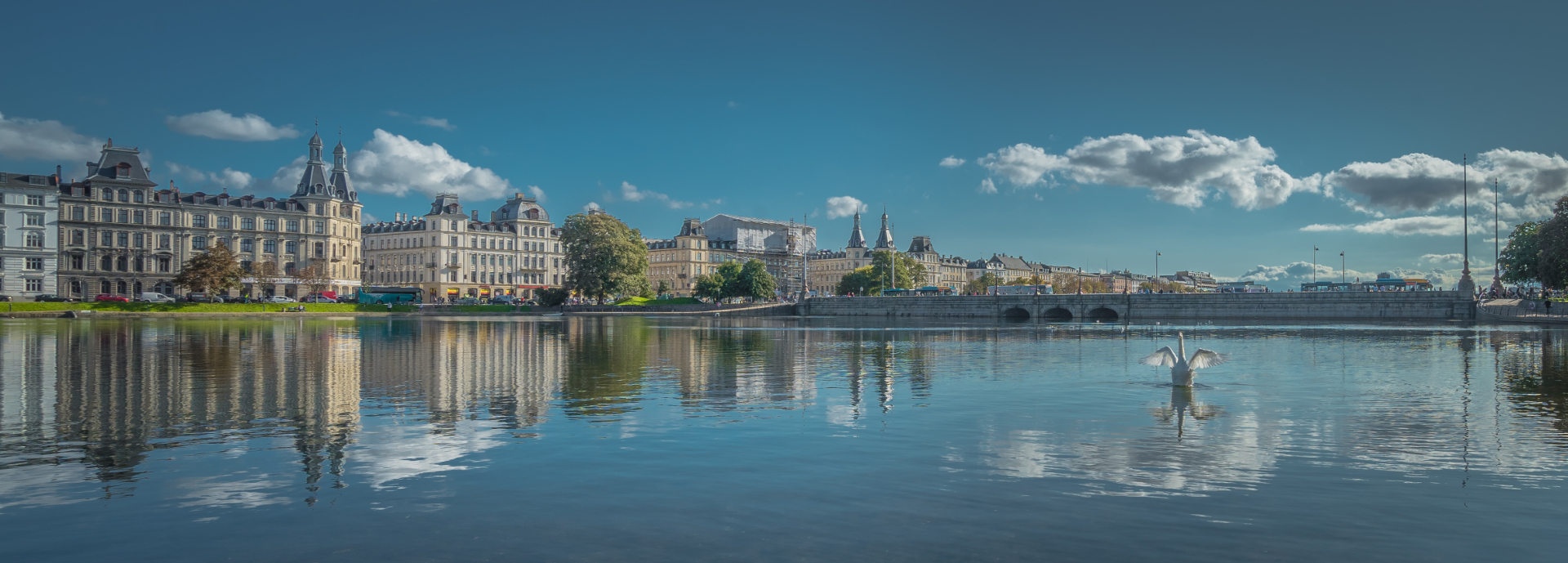 The next image is a low-light shot also using the new lens. Here too I'm very happy with the sharpness. Any non-sharpness is due to it being a very windy evening. Low-light was my big problem with my old camera and old lenses. You couldn't see where a blade of grass started and ended. It was all just an indistinct mess. Much better here, in my own opinion.
The next image is a low-light shot also using the new lens. Here too I'm very happy with the sharpness. Any non-sharpness is due to it being a very windy evening. Low-light was my big problem with my old camera and old lenses. You couldn't see where a blade of grass started and ended. It was all just an indistinct mess. Much better here, in my own opinion.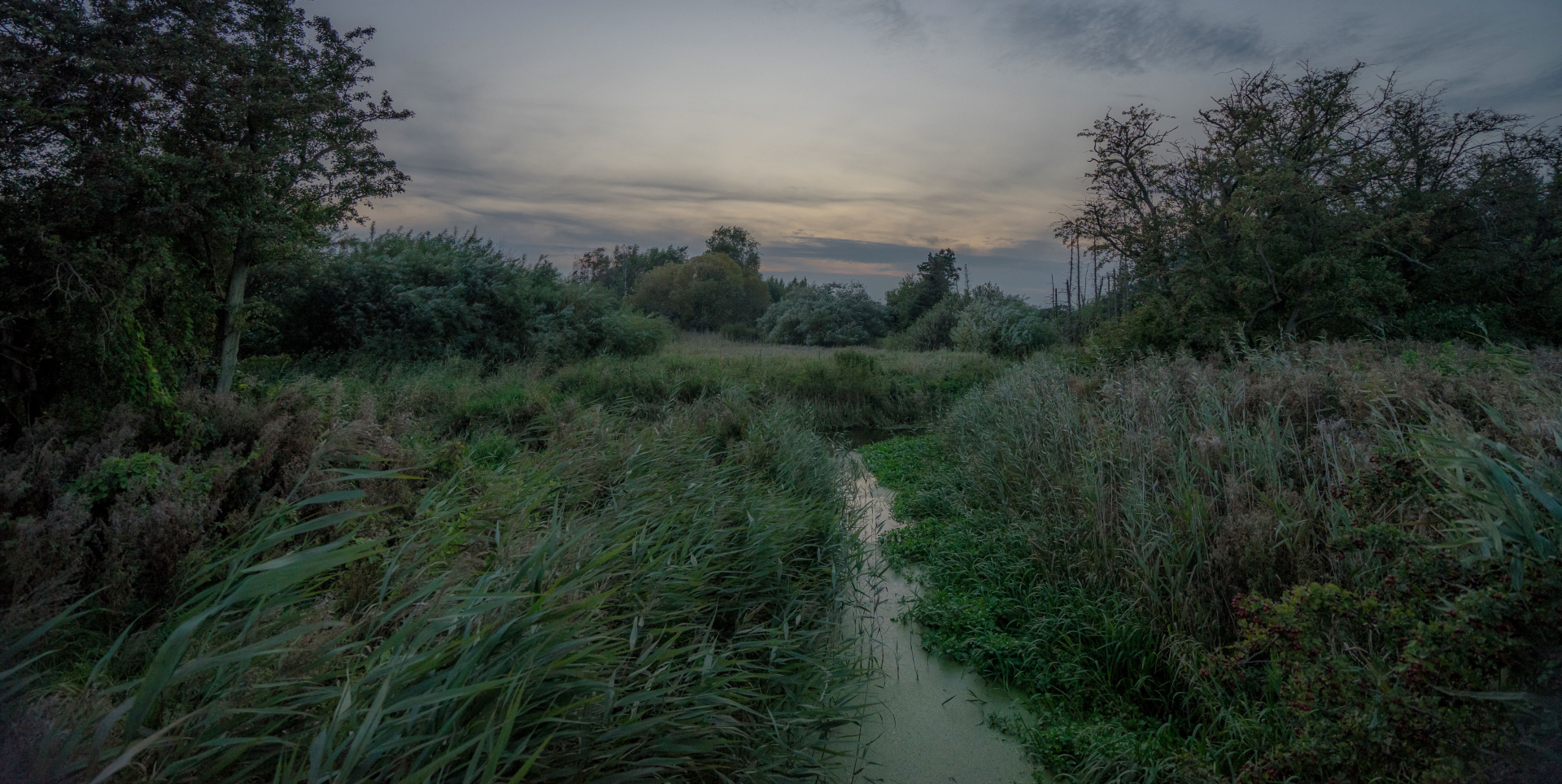 So while my new lens is the most important reason my photography has taken a turn for the better, there are other reasons, reasons that actually have more to do with post-processing than shooting.
So while my new lens is the most important reason my photography has taken a turn for the better, there are other reasons, reasons that actually have more to do with post-processing than shooting.
About a month ago, I finally lost patience with my old laptop that I normally used for photo editing. It was slow, constantly died from BSOD, and it was running out of disk space. At the same time, the price dropped on a laptop I'd had my eye on that would be a gigantic step up for me. So, I convinced myself I'd just saved a lot of money by not having to buy a wide angle lens and hit the "buy" button.
And what a difference it has made. Never mind how fast it is and that it has made Lightroom a breeze to run, the screen has made me realize that for all these years, I've been doing my post-editing all wrong. Looking at my pictures that were edited on my old computer, I see how awful they look. Way too much contrast, too much black, too much clarity. So, no wonder I'm not a rich and famous photographer! My pictures were ugly! That changes now.
Last... and maybe least, but it still deserves a mention: a brand new piece of photo editing software has given certain pictures the last oomph that really make them stand out. It's called Luminar and still only exists in a beta version for Windows (I think a fully developed version exists for Mac). While I love Lightroom and have no plans to abandon it, it's mostly suited for - and this may be due to my lack of skills in using it - a nice and proper result. Nothing wrong with that. But it takes more than that to get attention. Especially when you don't live near waterfalls, mountains, volcanoes, rivers, wild oceans, or whatever else will give you a natural advantage in photo contests such as the ones I frequent at ViewBug and GuruShots.
So here's a before and after example of a plain Lightroom edit and a Lighroom edit enhanced by Luminar. The first image is probably closer to "real life" than the second, but real life usually won't win you many "wow"'s and "oohh"'s.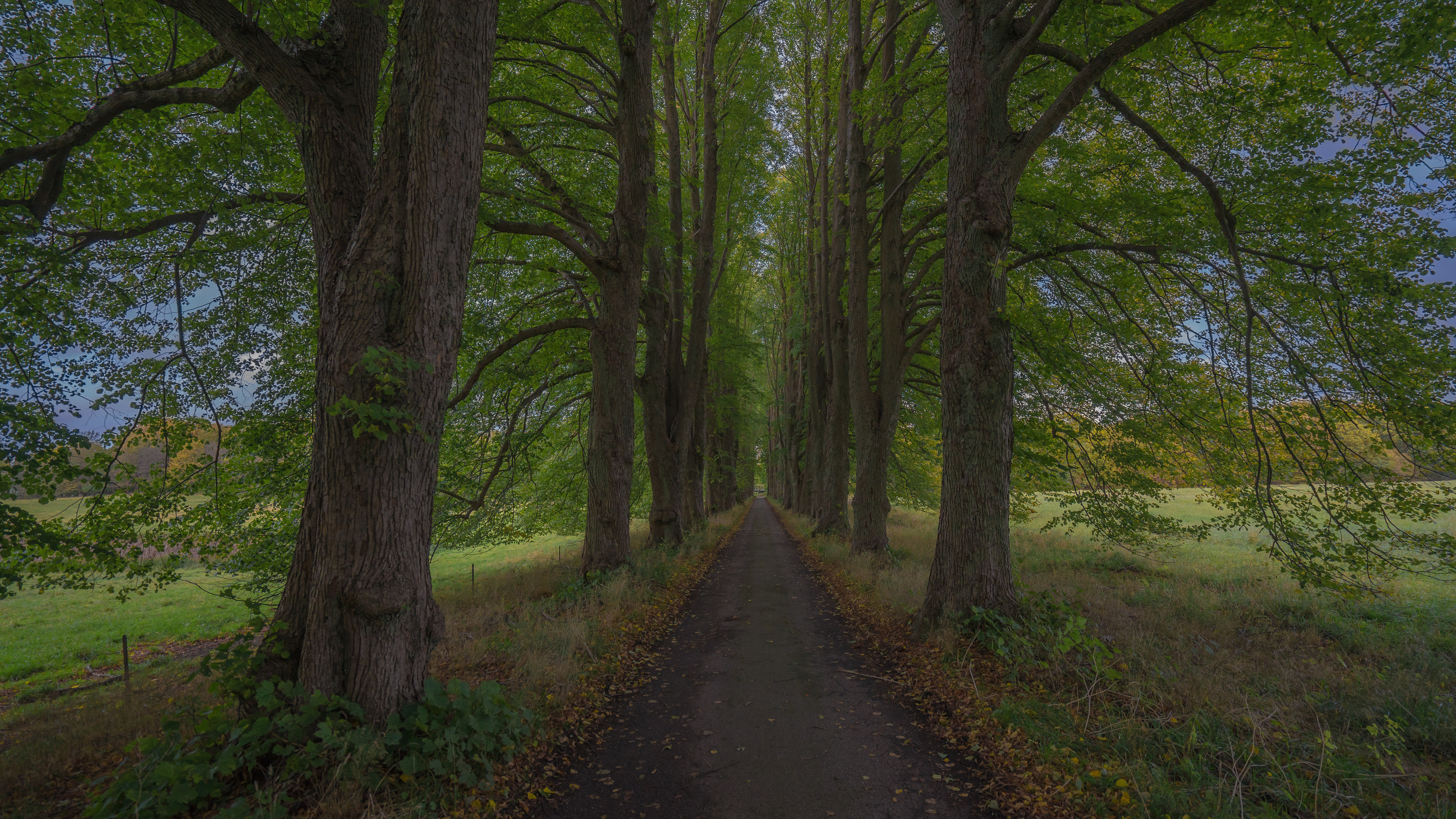
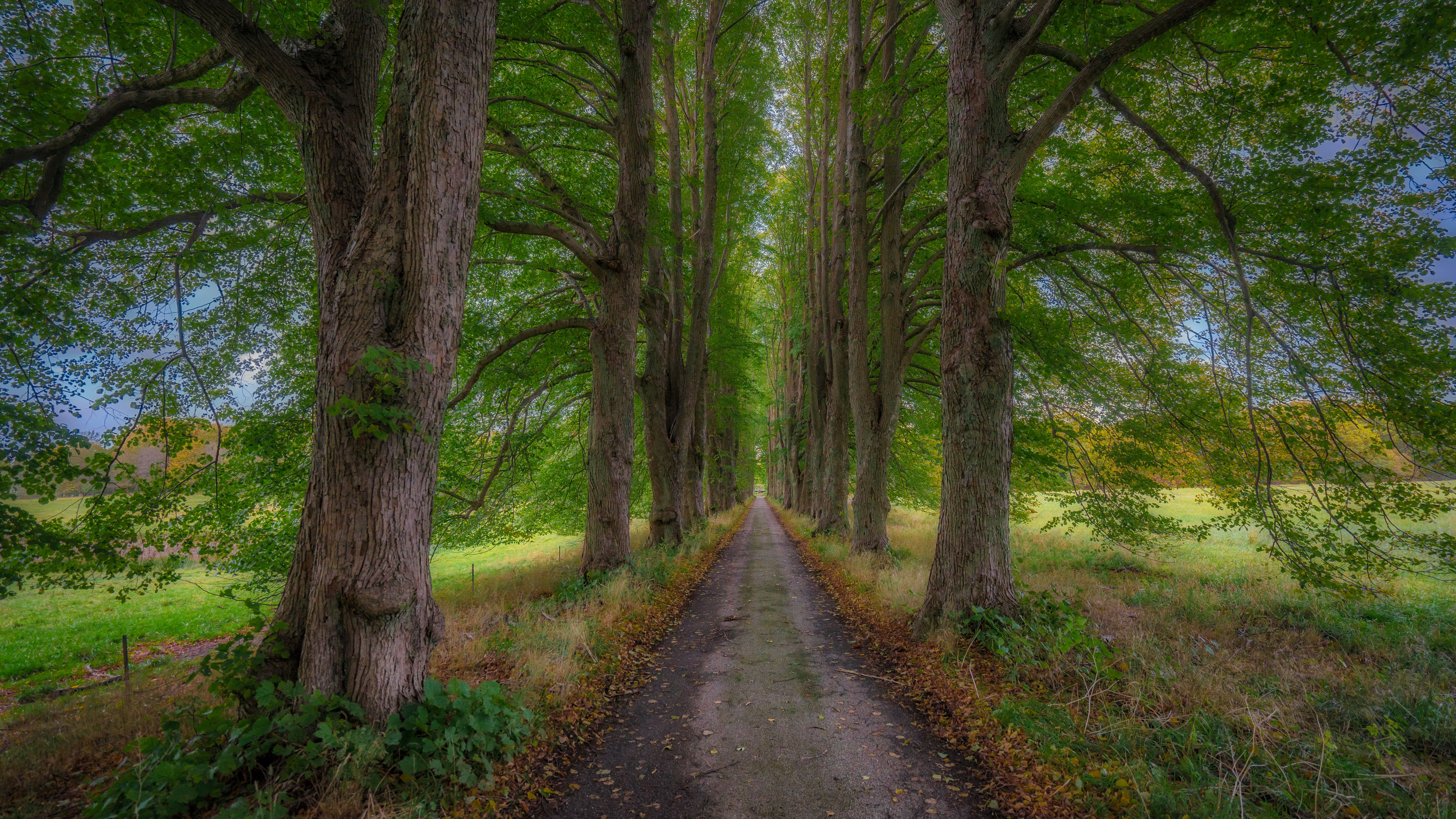 And just for the record, I don't post-process my images based on what I think will win contests (I won't win any contests, anyway), but mostly based on my own tastes. So, yeah, I prefer to look at the Luminar version, too, just like the majority of contest voters.
And just for the record, I don't post-process my images based on what I think will win contests (I won't win any contests, anyway), but mostly based on my own tastes. So, yeah, I prefer to look at the Luminar version, too, just like the majority of contest voters.
So, agree or not, in my own mind my photography is improving and that's really another reason I want to go out there and shoot - even if it's the same things I shoot over and over. It's invaluable practice for when I finally go to the really great locations.
Unlike good landscape photographers who know what they are doing, my photography has always been characterized by randomness, confusion, disorganization, and sometimes downright stupidty. Sure, sometimes the result can be excellent despite all this. I think I have a pretty decent eye for compositions, and I know my way around Lightroom, and that helps me.
But things like planning ahead, making sure there's a memory card in the camera, making sure I brought the quick release along with my tripod, charging the camera batteries; those things have often proven challenging to me and have caused me a good deal of frustration with myself.
So I've been practicing getting more organized and better at planning things. This reached the culmination so far the other day when I executed a plan that I had devised all the way back in July. During a little photo excursion to the other end of town, I came across the below scene and loved it.
Still, I wasn't all that happy with the shots I brought home. They were ok, but I thought they could be better... during a sunset.
So I used my PlanIt For Photographers app, which can show on a Google Map where and when the sun sets and rises, and saw that the sun would set right in that area come mid-September. I entered it in my calendar and started waiting.
Well, fast forward two months. Around September 10 I put myself on high alert to move out within an hour's notice if it looked like there would be a colorful sunset. I warned my wife of what may happen right around dinner time on any given night. My photo bag was packed, extra batteries charged - I was ready!
About a week into the target period, it happened. The skies seemed to align just right, with a good mix of clear sky and clouds. So I grabbed my camera bag and my tripod, got in the car, and drove to my destination.
I set up the equipment, the camera loaded with my brand new Sony 16-35 mm landscape lens, and started shooting. The sun was still above the horizon but hidden behind the clouds, which were turning an awesome yellow.
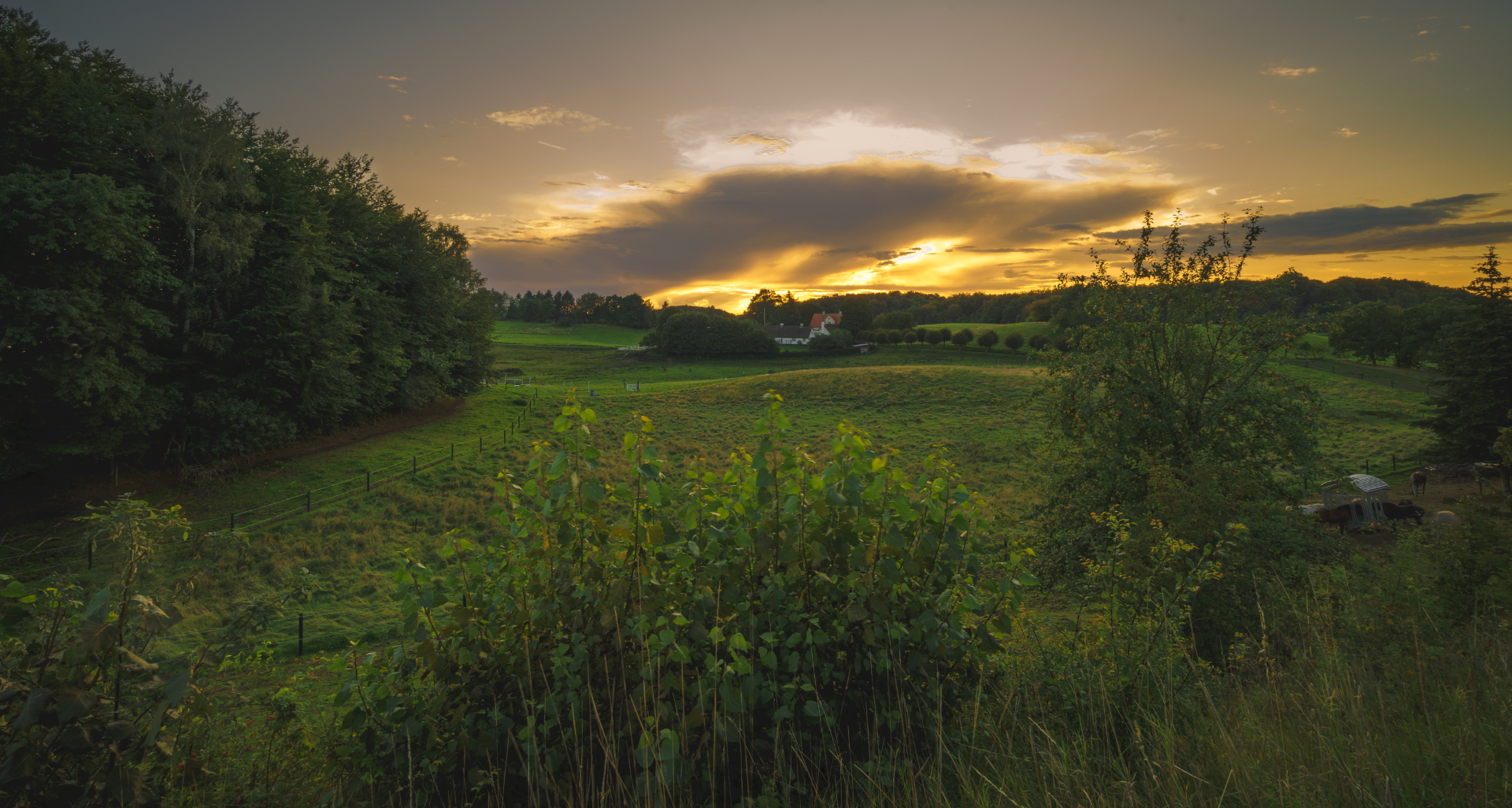 Just as the sun was disappearing behind the tree line I managed to capture the below picture, my favorite of the evening. I turned the aperture all the way down to f22 as I had read somewhere that a low aperture would generate the kind of beams that I, in my own opinion, so perfectly captured here.
Just as the sun was disappearing behind the tree line I managed to capture the below picture, my favorite of the evening. I turned the aperture all the way down to f22 as I had read somewhere that a low aperture would generate the kind of beams that I, in my own opinion, so perfectly captured here.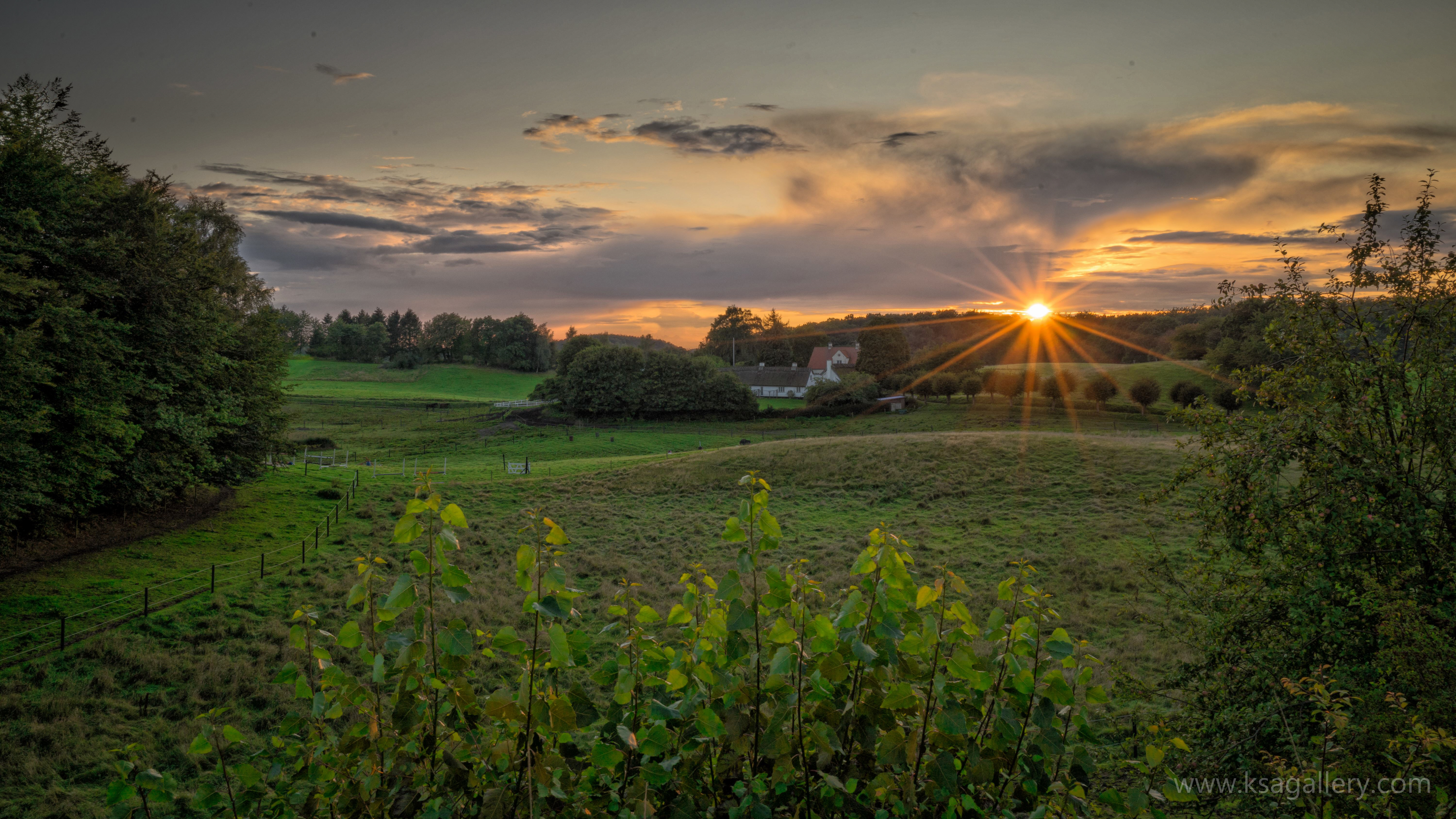 After the sun descended below the horizon, the colors in the sky remained for a brief period of time. It never became the color explosion that I had hoped for, but I was pleased. During my 40 minutes there, I captured a little over 30 images, experimenting with three different lenses, regular exposures, and long exposures. The long exposures didn't really add anything as the clouds were moving so slowly even a two-minute exposure didn't really capture any movement.
After the sun descended below the horizon, the colors in the sky remained for a brief period of time. It never became the color explosion that I had hoped for, but I was pleased. During my 40 minutes there, I captured a little over 30 images, experimenting with three different lenses, regular exposures, and long exposures. The long exposures didn't really add anything as the clouds were moving so slowly even a two-minute exposure didn't really capture any movement.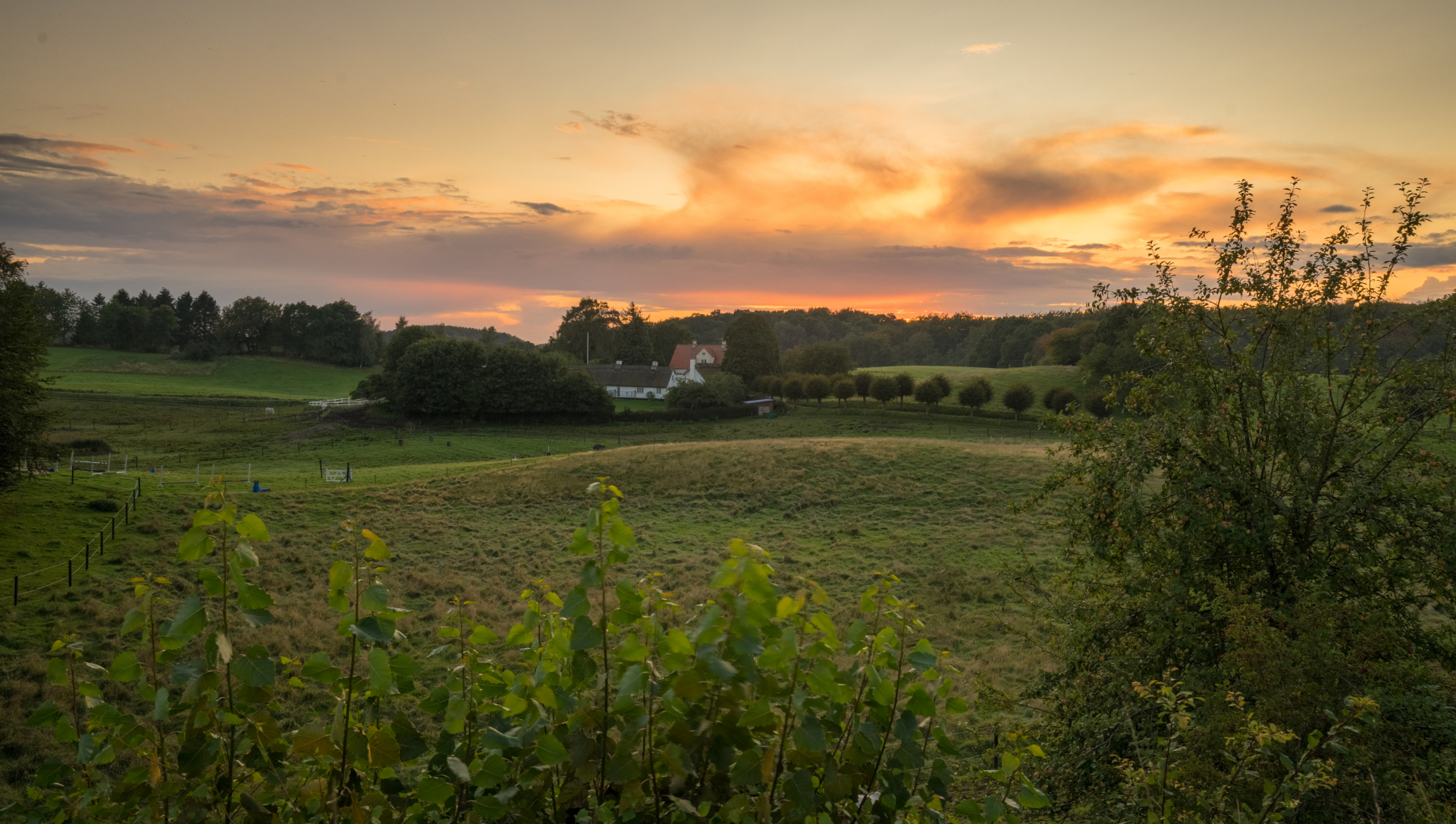 In the end, the evening was as much about proving to myself that I can plan ahead, pick a time and a location, and execute the plan successfully as it was about getting great shots. I think I did just that...
In the end, the evening was as much about proving to myself that I can plan ahead, pick a time and a location, and execute the plan successfully as it was about getting great shots. I think I did just that...
Oh, and the shots weren't too bad either.
I may not spend every other weekend going to a new location to take pictures. I would like to do much more of that, but so far that's just not happening, with real life and laziness being much too time-consuming.
Fortunately, for someone who doesn't get out as much as he should, I can only appreciate the opportunities that my immediate surroundings offer in terms of photogeneity. And when I say "immediate surroundings" I mean stepping out the door to the patio and walking 30 meters across the little child-friendly street on which we live. From there I have a westward view of our neighborhood, which in that direction consists of a green area, a bike path, trees, a housing development that is actually quite beautiful in my opinion... and, last but not least, sunsets. Lots of sunsets. From April to September or October, we are blessed with some pretty spectacular sunsets on evenings when the cloud cover allows it, which during those months happens on a fairly regular basis.
This is what happens on those evenings: orange, yellow, purple, pink, and red colors fill up the sky above the aforementioned housing development. I get up from the couch, grab my camera, and run out to capture it before it goes away, much to the confusion of my cats who will join me out there wondering what the hell I'm doing.
Back inside on the couch, I will glance out the window again and realize that, whoa, it's now twice as beautiful as it was five minutes ago. So once again I get up and go out there while frantically adjusting the ISO of the camera to the now slightly darker conditions.
This repeats two or three times a few times every month, so it's no wonder I end up with a few pictures that may be somewhat.... how can I put it? ...overlapping. But then again, look at the below selection of images, all from 2017. To my own eyes, there are worlds of difference in how those sunsets manifest themselves, and I truly feel all pictures are worthwhile additions to my collection.
I guess the moral of the story is that if stepping out your patio door is all it takes to create something unique and beautiful on a regular basis (and of course, that part is my own opinion... you may think I'm taking the same picture over and over), you don't have to feel bad about not being able to go to a new location every other week in order to be a great photographer. A little change in the cloud cover or lighting conditions in your own little neighborhood and you are well on your way to something fresh and interesting.
Still, don't take this as a call to stay home, but more like a comfort to you if, for a while, getting out there in the world, for whatever reason, is just not happening.
Photography has been slow lately. The last several weeks have been ridiculous weather-wise, plus I've been sick in the last week. I'm itching to get out there, especially since I unexpectedly became the owner of the landscape lens that I didn't think I'd be able to afford for a year at least, a lens that will, without a doubt, push me to the top of the landscape photography elite! More of that in a later post, of course. Today is all about catching up and talking about my summer vacation before it becomes but a distant memory.
If I had been doing this blog for the last 10 years, you might have noticed by now that most of my longer vacations are spent in the US, or Northern Idaho to be more specific. Not this year. This year we settled for a four-day getaway to Edinburgh, Scotland. I had never been to Scotland before, but it felt like a country that would suit me well when it came to things like climate, culture, and not least photographic opportunities.
I was not disappointed by any of those things. Of course, I could have done without the downpour that ruined part of our big bus tour to Loch Ness and the highlands, but oh well. We still had fun.
Anyway, after much consideration I have decided to simply post - and talk a little bit about - my three favorite pictures from the trip, and then add a slideshow video that will give you more of an impression of the whole experience.
The first image was taken on our first night in Edinburgh. It shows a canal near where we stayed. Apparently, the UK is full of these canals with their canal boats (which you will see more of in the video). This quay area with its modern architectural buildings and rustic boats made for a beautiful scene during the sunset, and with fantastic low-hanging clouds to add a little drama.
We returned the next evening because I thought I could do better, but the light wasn't as good, and in the end this image just turned out better than all the others.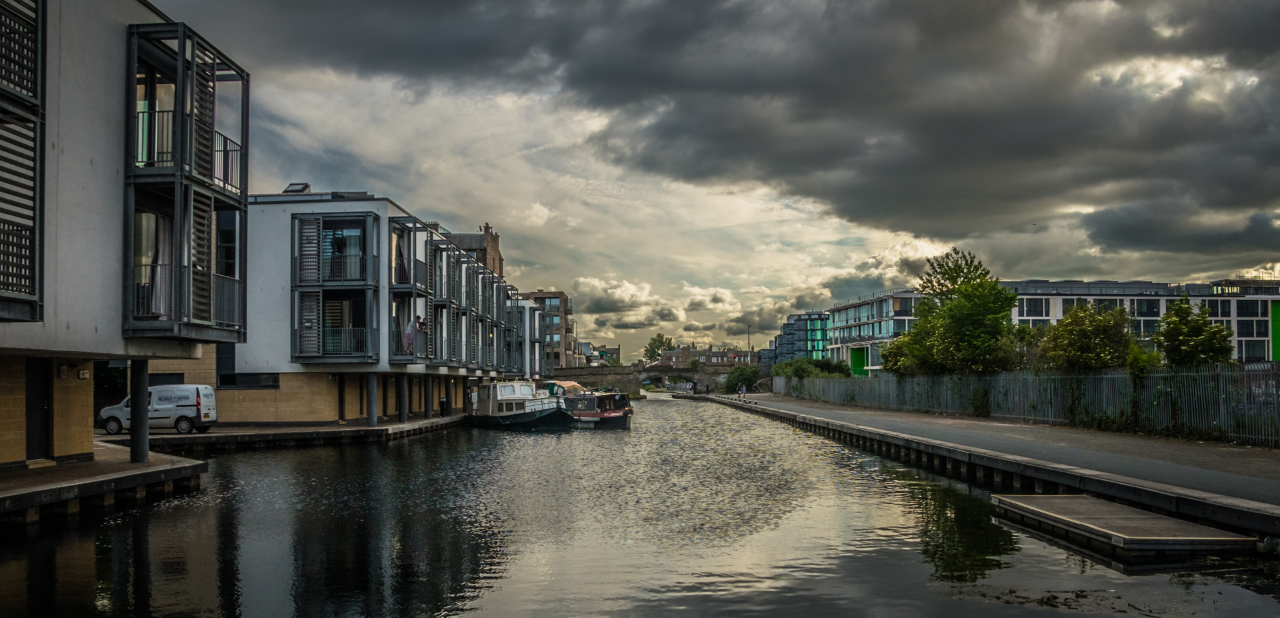 Below is, in my own opinion, a wonderful shot of Edinburgh Castle overlooking the connecting park. It was taken as the sun was setting and as we were walking back to our hotel after a long, long day of exploring the city. Our explorations had taken us all around downtown Edinburgh, including to, and inside, the castle itself. Needless to say an iconic construction like Edinburgh Castle offers countless photo opportunities, and with my usual, "better take 300 pictures too many than one too few"-approach, I couldn't have missed too many of them.
Below is, in my own opinion, a wonderful shot of Edinburgh Castle overlooking the connecting park. It was taken as the sun was setting and as we were walking back to our hotel after a long, long day of exploring the city. Our explorations had taken us all around downtown Edinburgh, including to, and inside, the castle itself. Needless to say an iconic construction like Edinburgh Castle offers countless photo opportunities, and with my usual, "better take 300 pictures too many than one too few"-approach, I couldn't have missed too many of them.
However, for all the architectural details and historical magnificence that the closeups revealed, this image, with the lush, green park contrasting the ragged castle walls, tells the story of how the city is, and always has been, dominated by the presence of the castle, for better or worse.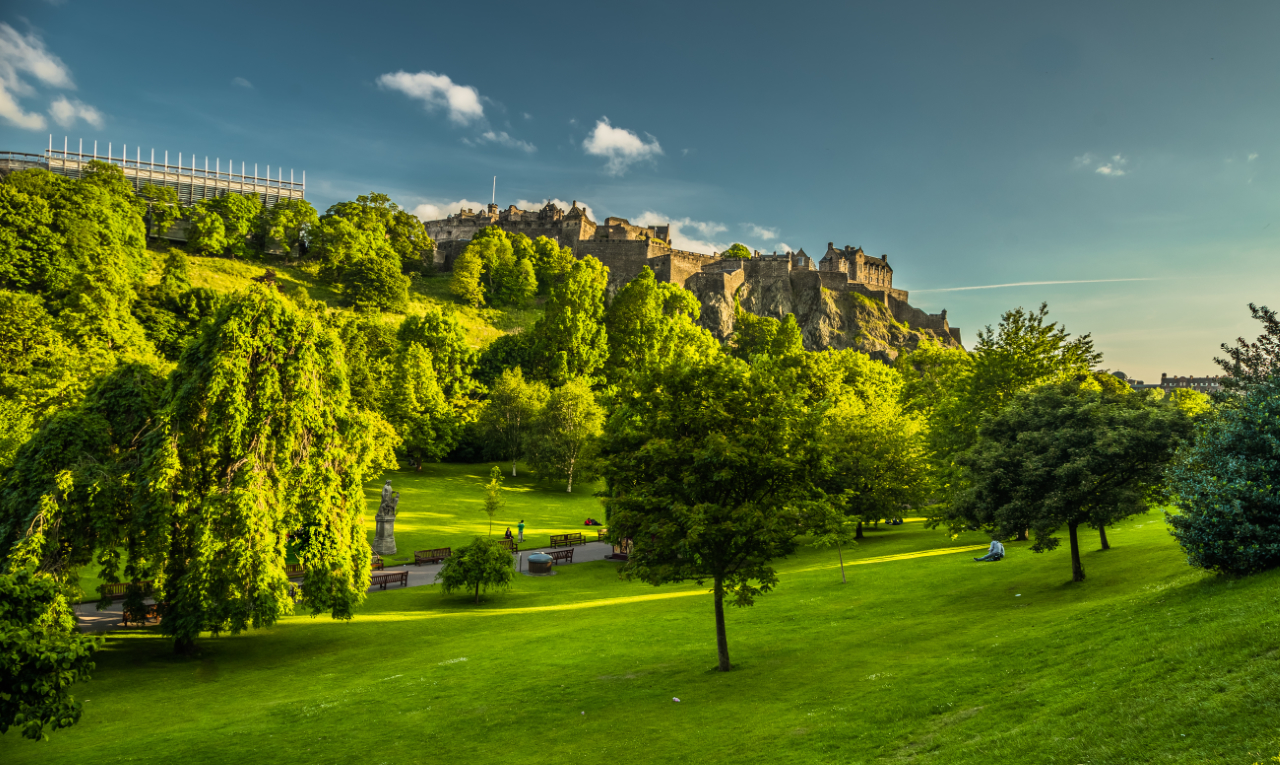 The last of the three images was taken on our last night in Scotland which offered both the photographic and emotional highlight of our entire trip. Almost as an afterthought we decided to climb the famous Arthur's Seat hill overlooking Edinburgh. I had been on one of the neighboring hills two nights previously, and while that had been a good experience and well worth it, I wasn't totally blown away and would not have been too disappointed if we hadn't made it up to Arthur's Seat.
The last of the three images was taken on our last night in Scotland which offered both the photographic and emotional highlight of our entire trip. Almost as an afterthought we decided to climb the famous Arthur's Seat hill overlooking Edinburgh. I had been on one of the neighboring hills two nights previously, and while that had been a good experience and well worth it, I wasn't totally blown away and would not have been too disappointed if we hadn't made it up to Arthur's Seat.
Well, I should have been! Arthur's Seat was a whole different experience. For one thing, you felt like you were at the top of the world. You could see for miles in all directions, and even with loads of other tourists up there, you had a sense of detachment from the real world. I could have stayed up there forever, but good thing I didn't, because then I wouldn't have gotten the below image, which was, in fact, not taken on Arthur's Seat (check out the video for that) but on the walk back down from there.
As soon as I spotted the old ruin a little off the track, I knew I was about to take some of my all-time best photos. Of course, there were plenty of ways I could have screwed it up, but short of a colorful sunset, which we just couldn't sit and wait for, and without a tripod to enable long exposures, I think I did about as well as could have been expected, which was pretty damn good. The dramatic clouds are a fine replacement for a sunset, and the image just has a feel of raw, ancient history of kings, wizards, religion, and long lost culture.
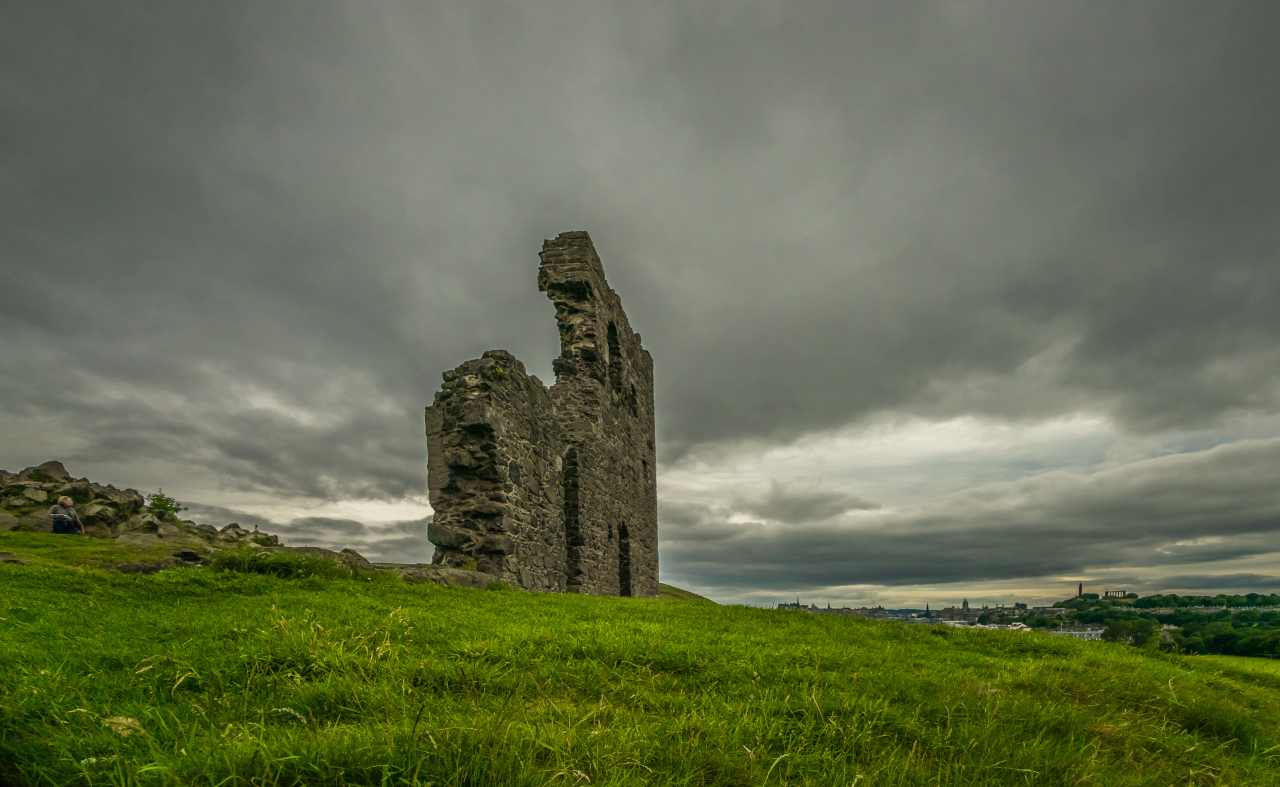 Of course, you didn't really expect me to only show three pictures from Scotland, now did you? The only reason I can limit myself to that is that I also made the below slideshow featuring another 80 or so images from four amazing days. You may want to make the player a little bigger and you definitely want to turn up the sound so you don't miss the beautiful music.
Of course, you didn't really expect me to only show three pictures from Scotland, now did you? The only reason I can limit myself to that is that I also made the below slideshow featuring another 80 or so images from four amazing days. You may want to make the player a little bigger and you definitely want to turn up the sound so you don't miss the beautiful music.
I once read that, according to science, the color green has a special effect on the human brain. Due to our origin in the jungle and other green surroundings, even for today's modern people, the color green unconsciously equals the presence of water and the absence of starvation, which again soothes the brain, gives us peace of mind, and makes us relax.
I believe it. I can feel it. Being in a green forest is fuel to my soul. I can't say for sure if it's the color green, or perhaps the quiet, or the smell, or a combination of it all. What I do know is that I live in a country with no mountains or rivers, but what we have instead - for a few weeks in May - is the most beautiful shade of green your eyes can behold. That's when the leaves of the beech trees burst open in cascades of light-green color that can take your breath away as much as any high peak or waterfall in more mountainous areas of the world . At least, that's how I feel, and it seems like the older I get, the more I feel it.
Of course, my interest in photography also helps me appreciate this special time of year even more, so it's no wonder that as the time draws near, I become anxious and look at the weather forecast to make sure I get out there on just the right day and just the right hour when light and color form a perfect synthesis. Well, at least according to my own feeling. I'm not assertive enough to claim I have the exact answer... And besides, sometimes work, your state of mind, and life in general have more influence on when you get out there with your camera than anything else.
What I do know is that - unlike the case with much other landscape photography - the time of near sunset or the blue hour are not the optimal times for green leaf pictures. The lack of light during those times of day prevent the strong green color from showing to the best advantage. The sun needs to still be - not necessarily high in the sky - but well above the horizon. The forest itself will ward off any harsh shadows and too much contrast that is otherwise a problem during afternoon landscape shooting.
This year I went out twice to try to capture the greenness at its peak. The first time, on May 12, was possibly a few days too early as, in many places, the leaves were still a tad too sparse. Still, I came away with some excellent results from a spot I've had success at before: a particularly beautiful forest edge near the Frederiksborg Castle Garden.
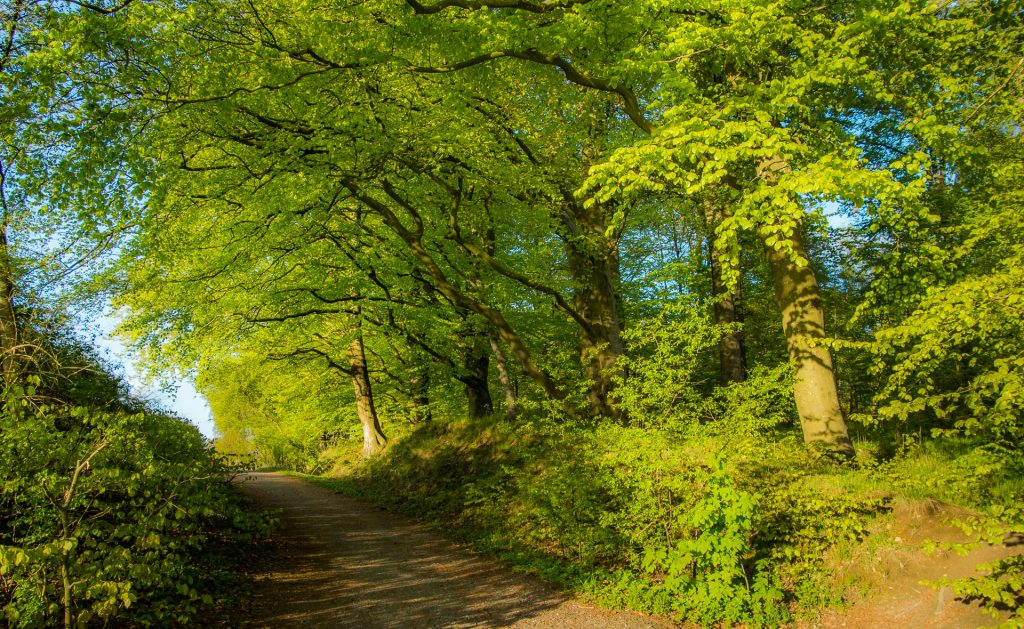
Still in the same neighborhood, this may be my favorite shot. The light coming in from the right highlights the exquisite green color. But this is about as low as the sun should get before there's not enough light.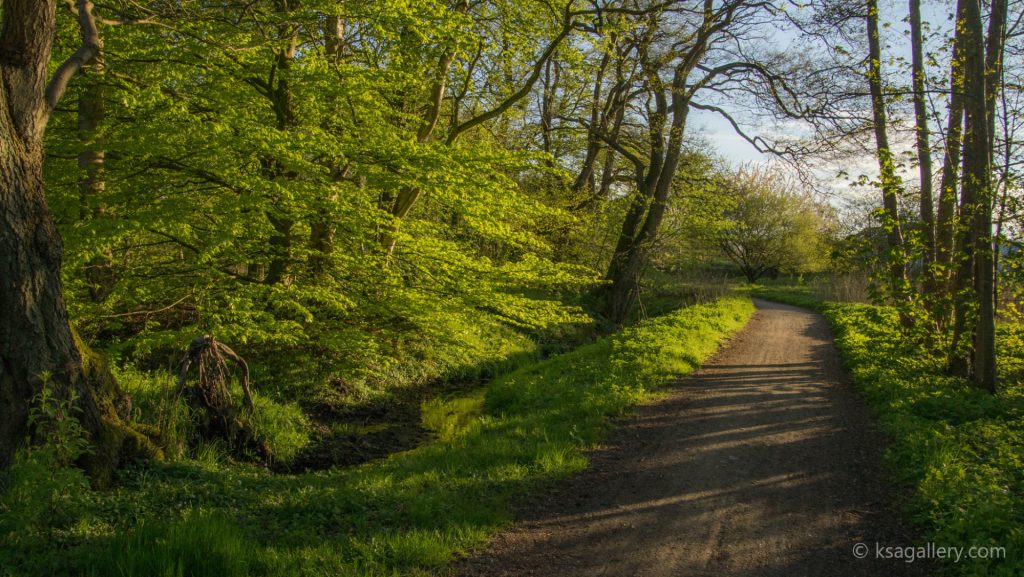
And yet, here's a picture taken several minutes later. The sun is still above the horizon, but it was becoming more difficult to emphasize the greenness. This is an HDR put together from two different exposures.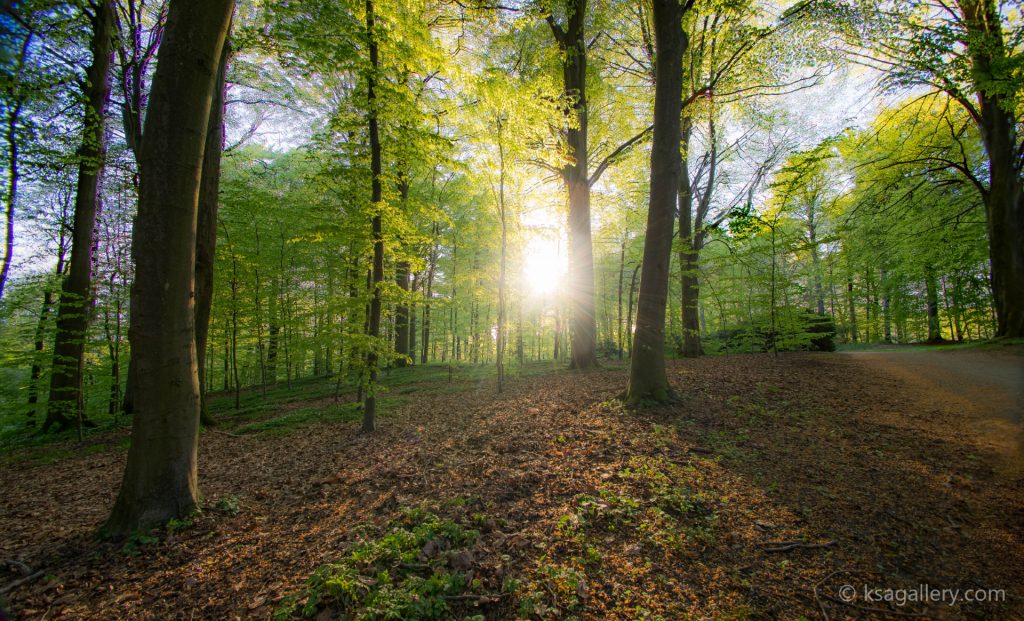 Realizing it was becoming too late to catch the green leaves, I headed for the castle where I took some really nice long-exposures, but that's for another post.
Realizing it was becoming too late to catch the green leaves, I headed for the castle where I took some really nice long-exposures, but that's for another post.
Instead I went out again a week later - a little earlier in the day and with the leaves now fully expanded and still with all the brightness preserved.
The below photo is my favorite one of the day. Perhaps because it is the one that most accurately reproduces the actual color that you see out there.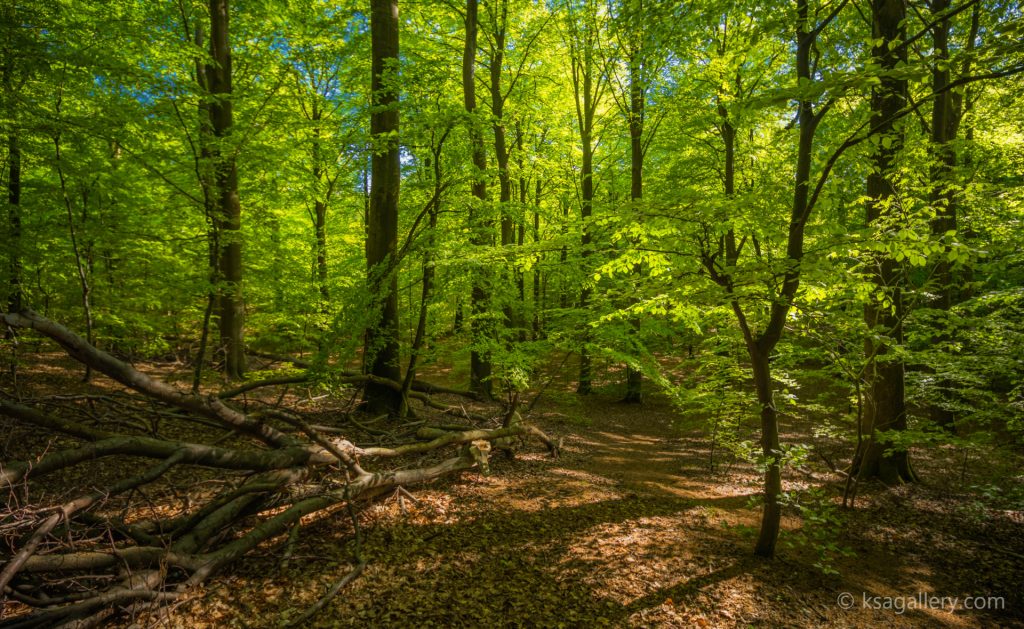
The last one is another HDR with some nice shadows.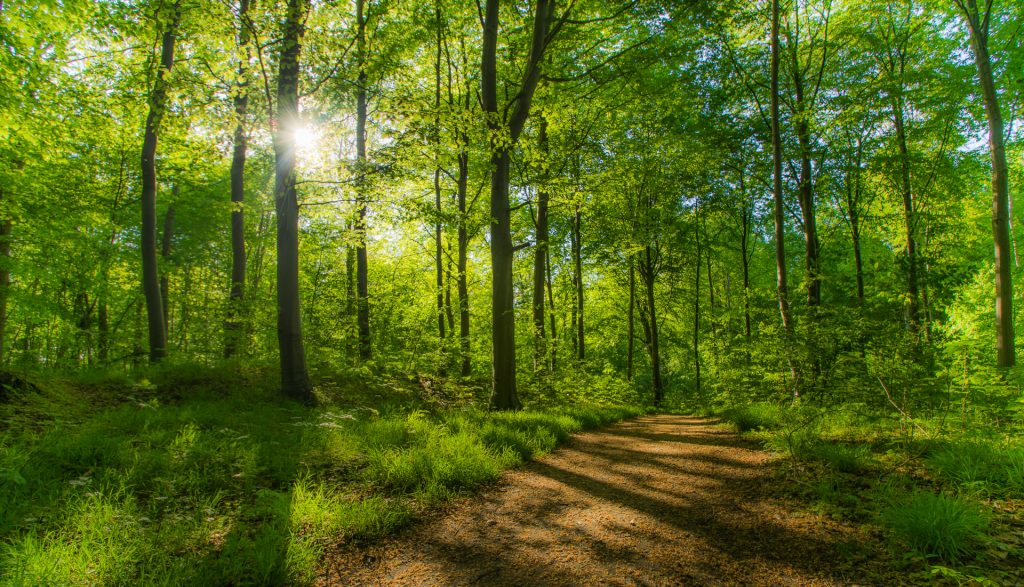
As with all pictures I post on this blog, these too have been submitted to some more or less heavy post-processing. Sometimes, I admit, the post-processing I do is to make the scenery look a little more... shall we say... "colorful" than perhaps it actually was. Here, the post-processing has served only one purpose: to make the pictures resemble reality, as reality in this case cannot be surpassed. A raw unprocessed photo will not do reality justice at all - at least not with my limited skills as a photographer.
One trick to improve an image of a forest is to go against your instinct to make it as sharp and clear as possible. Unlike with just about all other pictures, I reduce clarity in Lightroom when I post-process pictures of forests. You should try it and see what happens.
The time when the green beech forest is at its peak lasts only about three weeks and is now long gone. After that, the leaves start to turn darker. They are still beautiful, but there is nothing like those three weeks to invigorate your spirit, soothe your soul, and take some awesome pictures!
To all my readers who have been anxiously waiting for new updates (hello, dad and brother!), I'm still here and finally ready to talk about my latest photo explorations.
It's definitely not for lack of activity that I haven't posted in a while. In fact, since my last post here 1½ months ago, I have taken more than 1000 pictures! Of course, 90% of them will never go any further than my hard drive, and the amount of pictures may sometimes be more an indication of not really knowing what I'm doing than a burst of brilliant creativity.
So this is the first step in attempting to catch up with everything that has happened since I bought the new camera. For that I have to go all the way back to April 10 and a beautiful vacation day that was just perfect for taking pictures, with just the right mix of clouds and blue sky, and temperatures that were finally bearable after a long cold, gray winter.
So I took my bicycle on the train and went all the way to the Copenhagen Airport metro station. No, I didn't get on a plane to Iceland or anything fancy like that. Instead I jumped on my bike and rode down along the coast, passenger planes passing right above me at low altitude for their runway approach. And yes, of course, I did stop to take pictures of them, with the Öresund Bridge, between Denmark and Sweden, in the background - a recurring ingredient throughout the day, it turned out.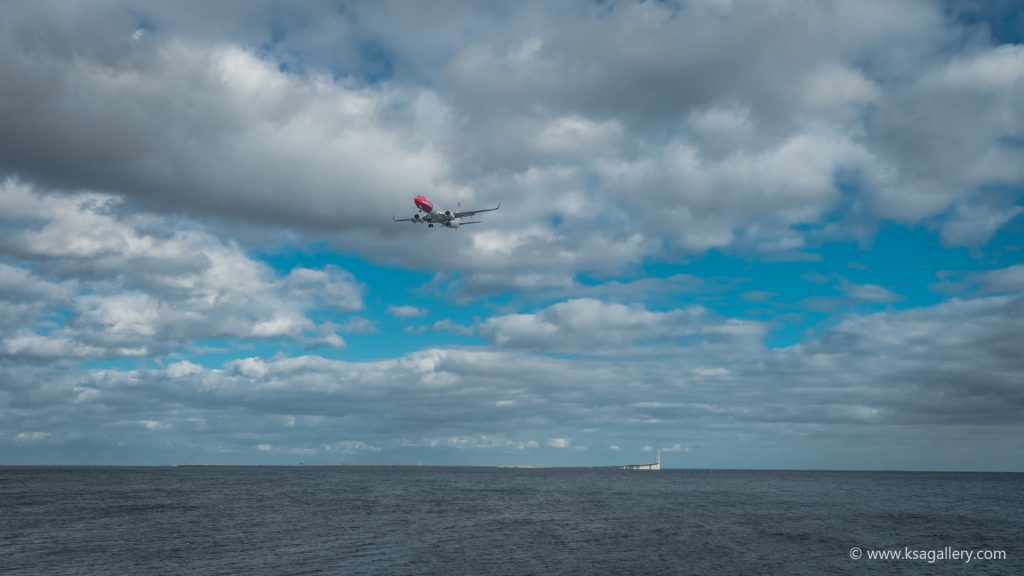
My target for the day was actually not the airport, but the village of Dragør, a small town south of Copenhagen strangely unaffected by the presence of Scandinavia's largest metropolis just a few kilometers to the north. In order to get there, I had to follow a bike path along Amager Strand, a beach area that I hadn't really given much thought during my planning. But as it turned out, the beach area was a scoop in its own right.
Now, by all measurements Amager Strand is probably nothing special - just a typical Danish beach - but 1) since I don't get out much, and 2) since I see everything with new eyes after I got into photography, to me, Amager Beach was a revelation. I was awestruck by its beauty and briskness, and I knew Dragør would have to wait a bit as I carpet-shot the area with my Sony A7 II.
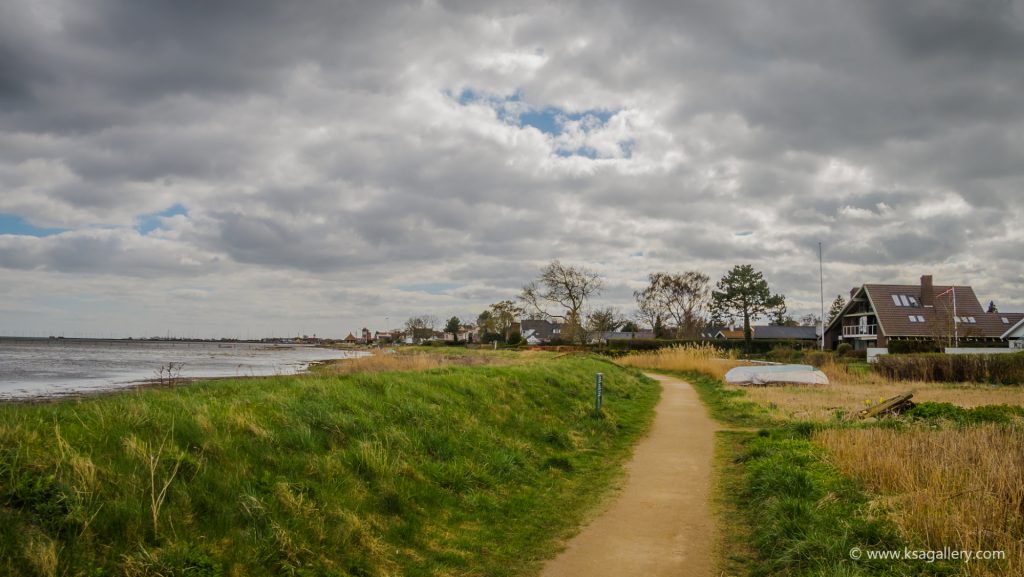
One of the most interesting features of the beach was a number of narrow docks stretching far into the water, a perfect opportunity for photographers such as myself looking for leading lines. The below image was one of the first of many, many that I took of this phenomenon and probably the best. Possibly because it was the only one I managed to take using a bit of long exposure. See, while I deliberately hadn't brought my tripod (it would have been too clumsy to carry it on my bike), I did bring my beloved Platypod, figuring that would be enough. And yes, it would have been enough if it hadn't been for the fact that you can't use a Platypod without your ballhead. And where was my ballhead? You guessed it: still attached to my tripod 40 kilometers away at home.
So what I did for this image was to put the camera on top of my backpack to elevate it just a little from the boards. But while I did get this shot in the bag, a backpack just doesn't cut it so I quickly reverted to hand-held.
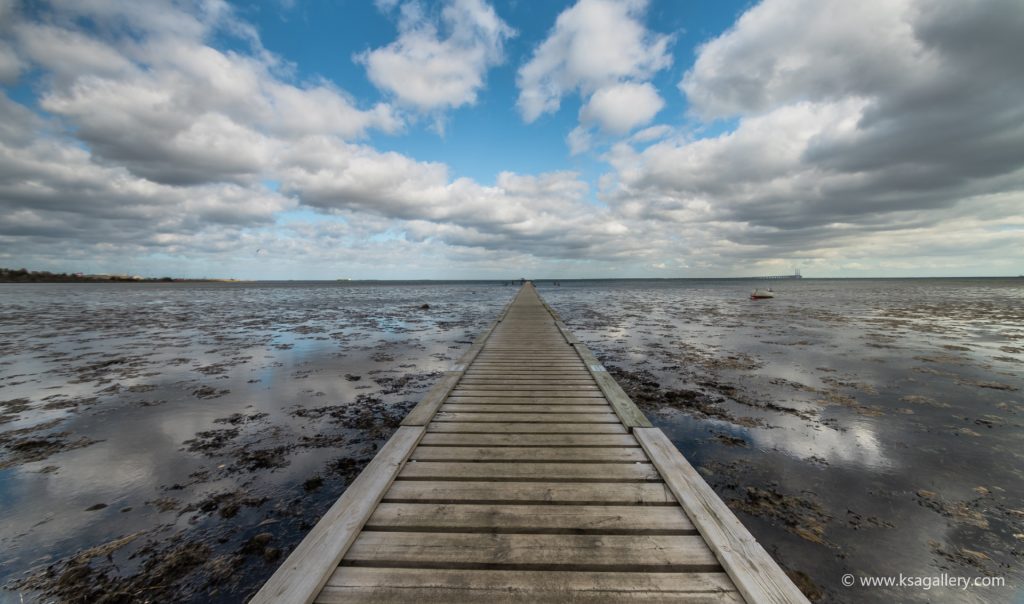
This next image is one of my favorites of the day. I like its simplicity and balance. I can only imagine the scene during a sunrise. That's for another time.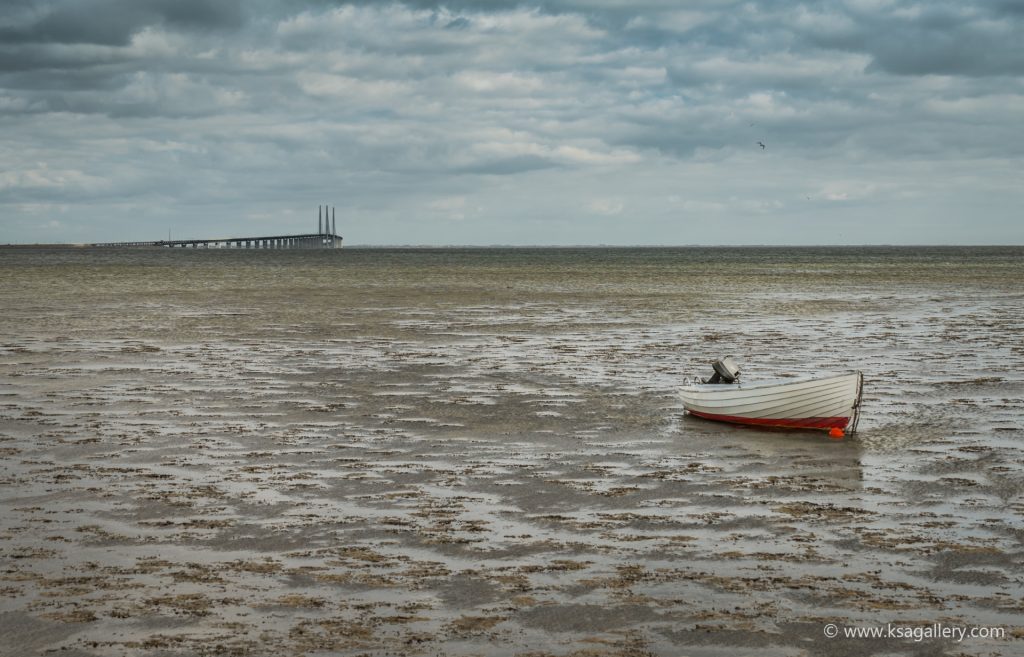
As I roamed the beach, planes kept coming in. When one had touched down on the landing strip beyond the dike, the next one would appear in the sky for its approach. I took dozens of pictures of planes. Most of them are useless because, although the planes came in low, they still appear rather tiny in the pictures - unless you crop them really tight, in which case they were just rather bland pictures of airplanes, and you missed the scene with the bridge in the background. This is where a monster zoom lens might have done wonders, but oh well.
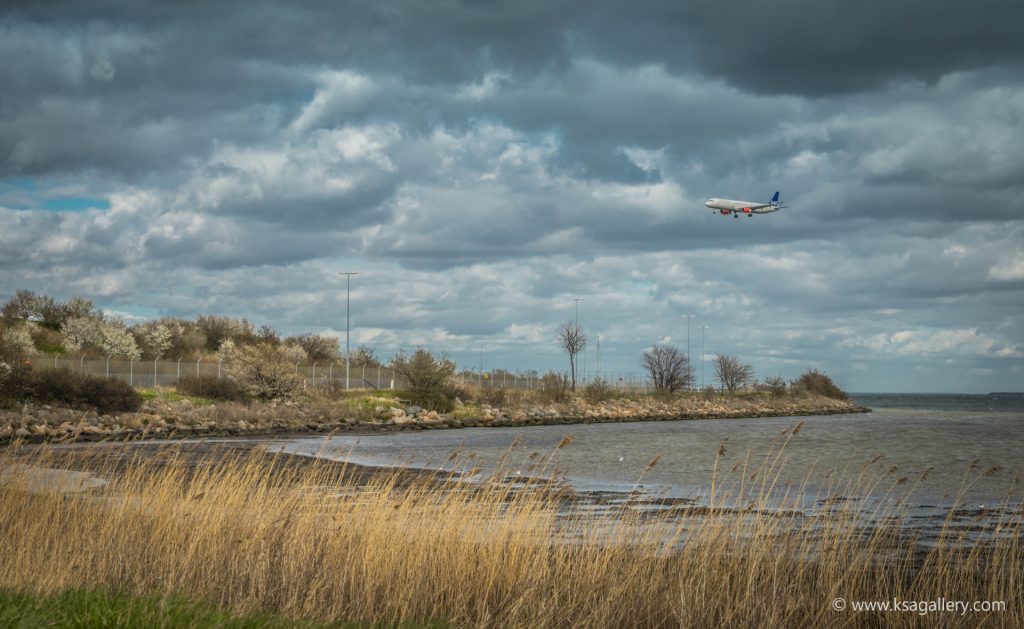
Well, I finally reached my destination, the town of Dragør, famous for its yellow thatched-roof houses such as this one in the image below. Entering the village, you feel like you are stepping 100 years back in time.
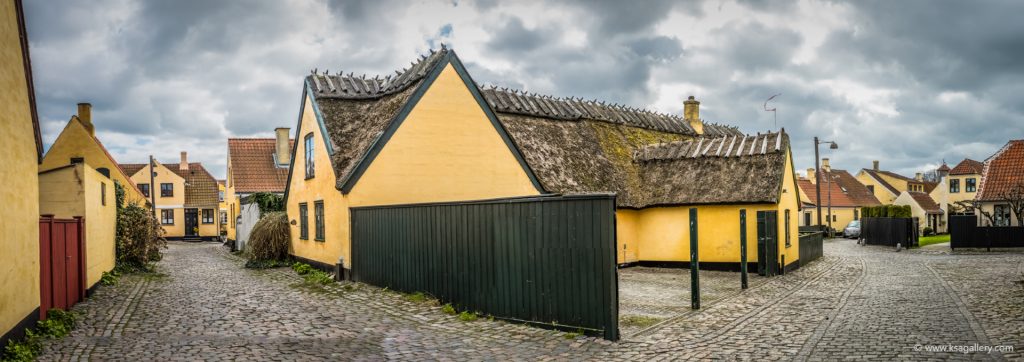
It didn't hurt that, just as I was walking down the street, a crack opened in the clouds and allowed rays of sunshine to shower the houses in the kind of light that makes a photographer's arm hairs stand up.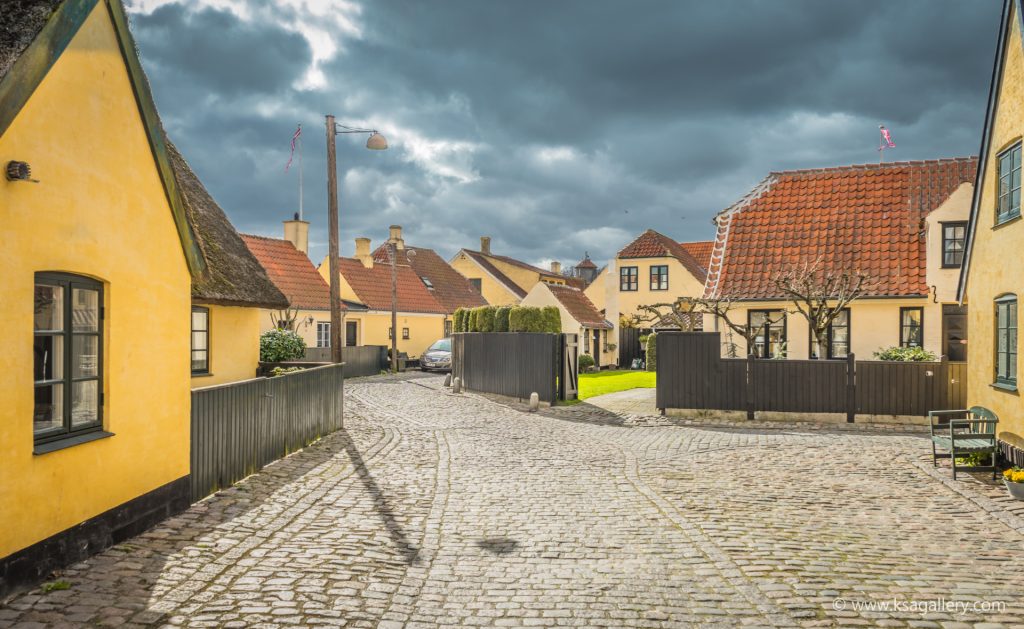
After walking around town for a while, I spent some time at the local marina. I included a picture of that in my last post, so here instead is another one I took there of two seagulls chasing each other.
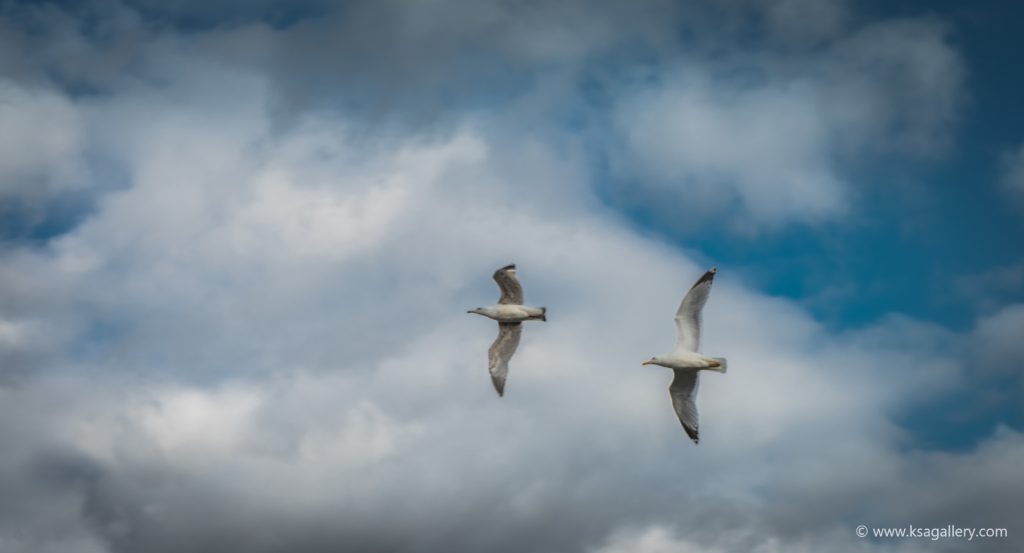
My day of shooting was coming to an end. I fought my way back to the airport on my bicycle with a head wind that felt like a cyclone, but I had enough energy to capture this stitched panorama of Terminal 3 that I was quite pleased with.  I actually captured in the neighborhood of 400 pictures on this day alone. It seemed like every way I turned, every airplane I saw, every building I passed was an opportunity that couldn't be missed. I ended up with a ridiculous amount of very similar pictures with only a few great ones. In hindsight, I regret not using the zoom lens that I do have (270 mm), but then again, that would have required a tripod... and a ballhead.
I actually captured in the neighborhood of 400 pictures on this day alone. It seemed like every way I turned, every airplane I saw, every building I passed was an opportunity that couldn't be missed. I ended up with a ridiculous amount of very similar pictures with only a few great ones. In hindsight, I regret not using the zoom lens that I do have (270 mm), but then again, that would have required a tripod... and a ballhead.
In the last few months I've been feeling a growing itch in my body. I've been feeling that I had somehow hit a wall with my photography. While my eye for a good motif, and my ability to capture it, kept improving, my camera was becoming the weak link. I felt that even when I did everything right, using the right exposure, the right aperture, a tripod, etc., the technical quality of my pictures - especially in low-light scenery, left a lot to be desired. I started to look for a new lens, but realized my camera's A-mount system was an obstacle. The selection of A-mount lenses just isn't very good. Besides, my old trusty Sony A33 increasingly started to feel like a beginner's camera. I felt I had moved on from the beginner stage.
To make a long story short, I itched for a new camera. I knew it had to be a Sony again, but with the more future-proof E-mount system that would, at the same time, allow me to reuse my old lenses with an adapter.
After pretty thorough research - and with the advice from my more technically adept brother - I chose a Sony A7 II. While by no means Sony's top model, it has all the qualities I can realistically hope for with my budget. And with the right lens, there's no reason I shouldn't be able to take pictures that until now I could only dream of.
The right lens, however, is still a thing for the future. My economy can only take so much camera equipment in one month... possibly year. So for now I have to make do with my old lenses and the generic lens that came with the camera. And that's ok. There are plenty of new features in the camera itself that should help improve picture quality even with the old lenses. A lot of that, however, takes practice and studying, something I haven't done much of yet. So in my first few weeks of using the camera, I can't say that I have utilized its more advanced features much, just as I haven't pushed it to its limits by doing much low-light photography or other challenging exercises.
Still, the following pictures, all taken with the new camera and with the included lens, show a lot of promise of what it's capable of.
The first one is a well-known motif: Frederiksborg Castle, a stitch of six handheld images. Nice, sharp, and crisp.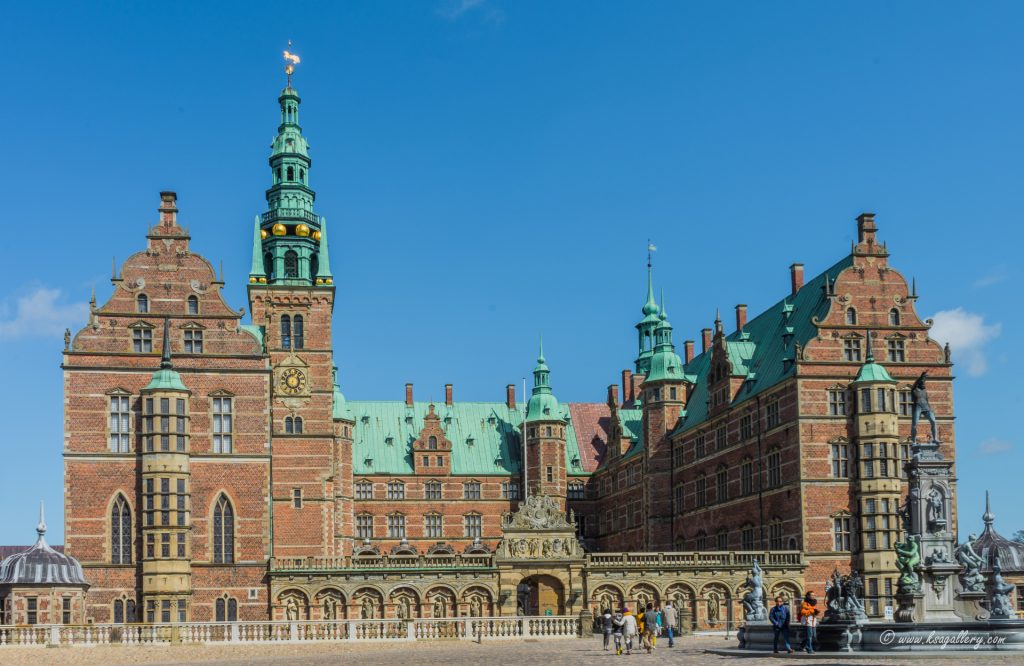
Seagulls at the harbor in Dragør during a photo excursion that I hope to write a separate post about soon. I wish the background of this shot hadn't been so messy, but I'm happy with the sharpness, achieved at only 1/160 second, in a burst of shots that made the memory card stumble to keep up.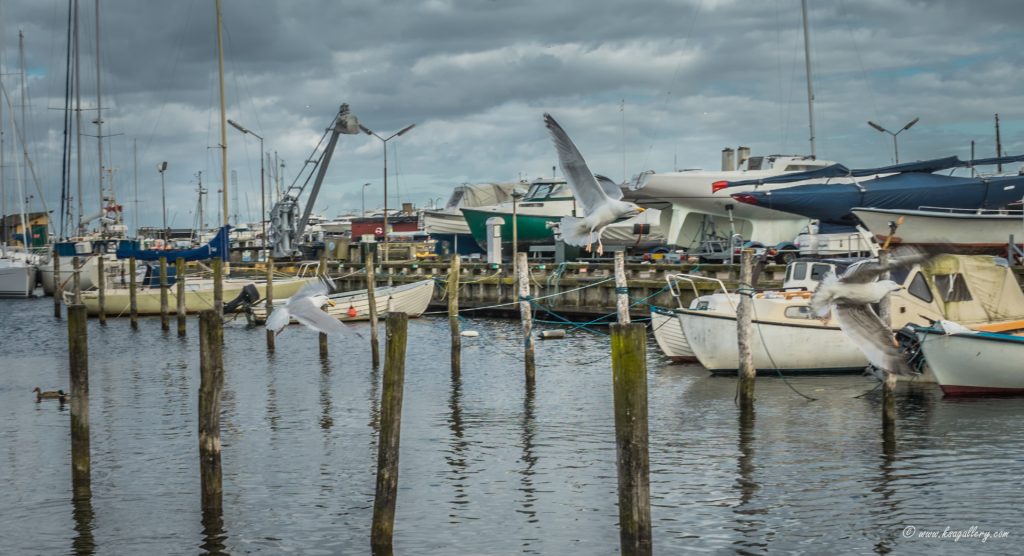
Another personal favorite of mine from my trip to Dragør. Again, notice the lack of blur, particularly in the waving flag. And boy, was it windy that day.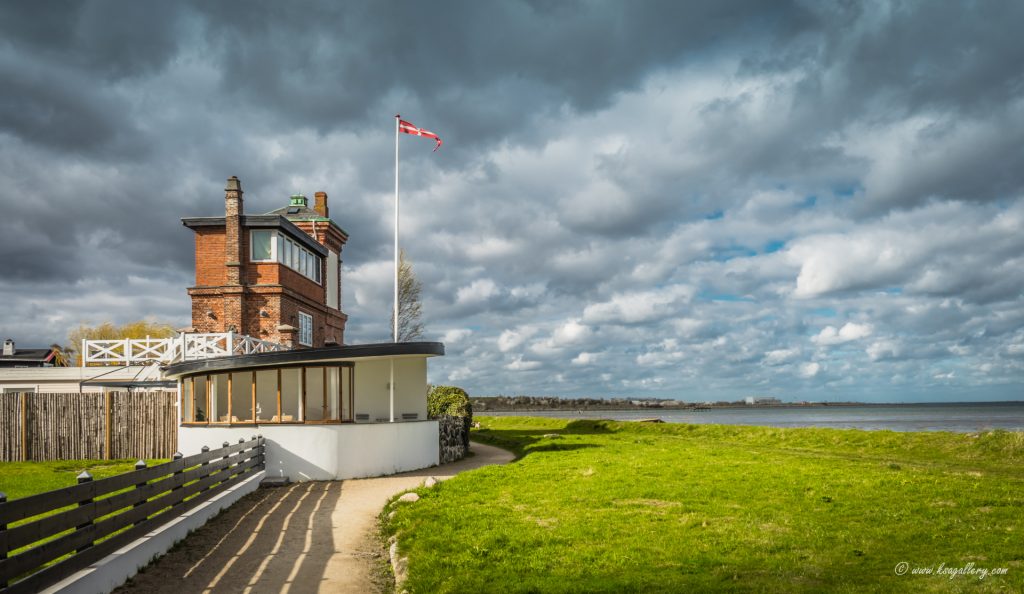
The only non-handheld picture of the bunch, and again from my Dragør expedition. That's me testing the app that comes with the camera and that turns your smartphone into an advanced remote control. Awesome! I always had trouble with remote controls for my old camera. This new smartphone system just worked. And the picture? There's a crispness about it that I just don't think I could have achieved with my A33.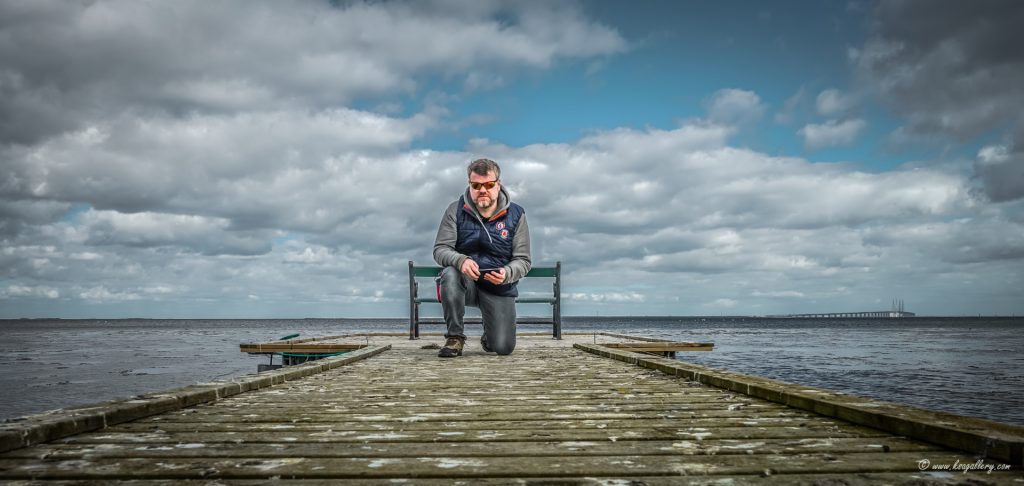
Next is my only attempt at low-light photography so far. Just the view from my backyard captured with a handheld shot at ISO 320 and 1/60 second. I think this demonstrates A7 II's anti-shake qualities in a big way. And the noise? There was none detectable. Definitely an improvement over my old A33.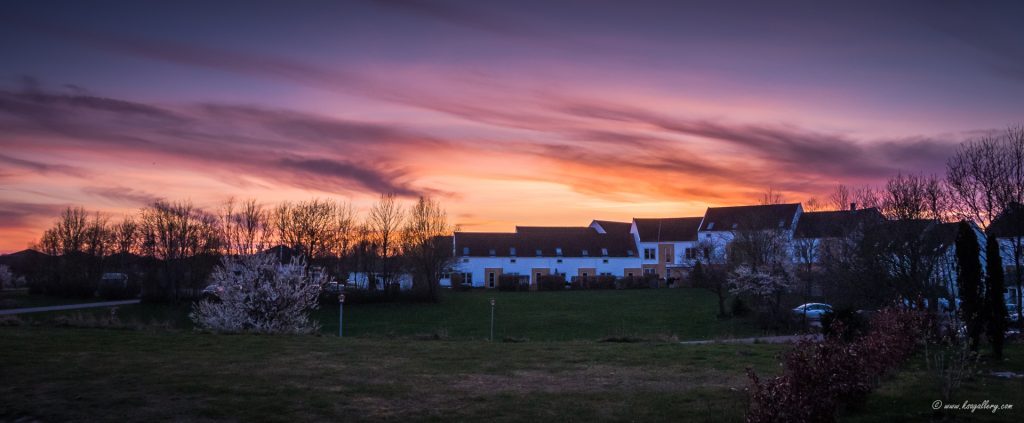
A picture of our neighbor's beautiful cat Ollie. Here I have experimented with A7's manual focus, adjusting the focus to the cat's eyes, something that wasn't even possible with my A33. Yes, I admit, I enhanced the eyes in post-processing, but still...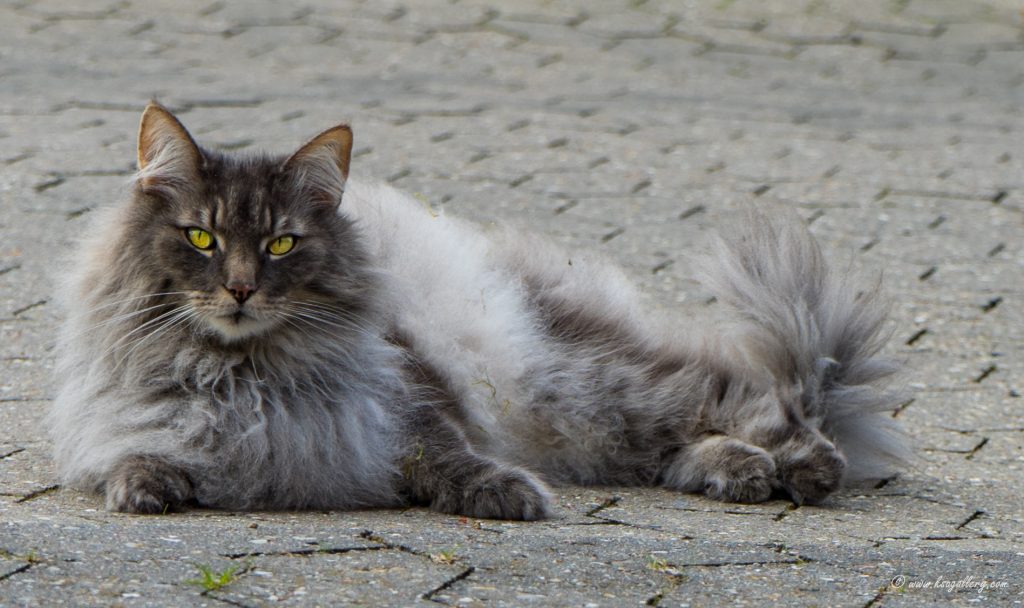
One of my favorite pictures that I have taken so far, not just with the new camera, but... like... ever. I don't know if it tells a lot about the camera, but I'd like to think I couldn't have achieved quite the same result with my A33. All I know is that I had to include it here because I just hit the nail on the head with this one, if I say so myself.
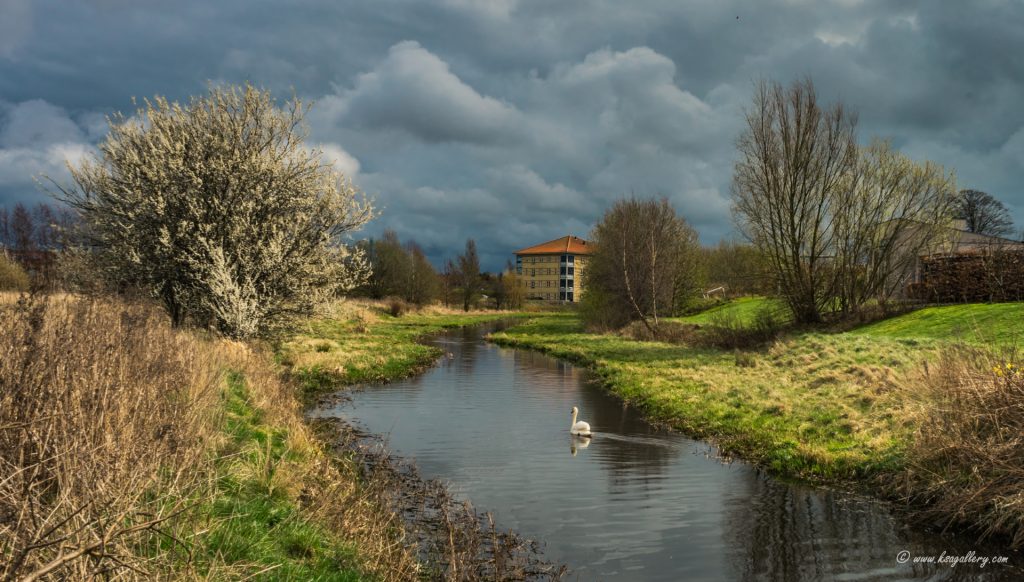
Well, the days are getting longer, the beech trees will explode in green within a few weeks, life is returning to nature, people are coming out of their houses, and I will be there to document it all with my A7 II. So keep an eye on this spot. I can feel this will be an extraordinary photo year.
This is the second installment of a series of posts where I review the photo sharing sites that I frequent. My posts are not meant as in-depth investigations of the pros and cons of the various sites, but rather my impulsive thoughts based on my sometimes rather infrequent activities. In other words, any negative comments I make are probably completely unfair, because surely, if I had invested more time and energy (and money) in each site, I would have gotten more out of them.
But the thing is, I believe I’m probably like most users in that I don’t have the time to systematically and strategically build up a following and become really popular, or have the money to buy myself more exposure – and even if I did, my pictures are probably not good enough, anyway.
So, 500px… what can I say? There’s no doubt you will find some of the world’s most amazing photographers posting there. Go to the “Discover” section of 500px and you will see some of the best images you are likely to ever lay your eyes on and that each receive hundreds and sometimes thousands of likes from other users. There are multiple categories, all with beautiful pictures, but the “Landscapes” category and “People” category - also known as “pictures of seemingly under-age, Lolita-style Russian girls posing half-nude” – seem to be the most popular (why are they always Russian? And with such a big country, why don’t they have beautiful landscapes to shoot, too?)
Unfortunately, I haven’t found a way to see an “all-time most popular pictures on 500px” list. Maybe such a list would just be too dangerous to look at as you might overdose with awe. What is certain is that if such a list exists, I won’t be represented. Why? Because here’s what happens when I post one of my pictures on 500px - and mind you, I only post pictures on 500px that I’m certain are masterpiece that will finally secure me a place among photography legends such as Trey Ratcliff, Ansel Adams, and Peter Lik:
1-5 minutes after posting: my picture receives several likes. Every time I refresh the page, more likes have been given. I’m cautiously optimistic that this is indeed my long-awaited breakthrough.
5-10 minutes after posting: I receive an e-mail informing me that my picture can now be found in the “Upcoming” section, which apparently requires in the ballpark of 10 likes. Still sticking to the path leading to fame and fortune.
10-20 minutes after posting: the likes keep coming in, sometimes in bunches of 3 or 4 after each refresh. I pass the 20 and sometimes even 30 likes threshold. I’m getting more and more excited.
20-30 minutes after posting: I receive an e-mail informing me that my picture can now be found in the “Popular” section. This corresponds to a value of almost 90 on 500px’s “pulse” scale, which goes to 100. In other words, I’m 9/10 of the way to the top! I cannot fail. I’m ecstatic and start to make plans to quit my job and become a full-time photographer.
31 minutes after posting: the picture is dead. D-E-A-D… dead. It may receive one or two more likes in the following hours. Then it’s never heard from again. Ever.
The above progression – where reaching “Popular” status is a kiss of death - is pretty accurate of how most of my pictures fare. I’ve had a couple of pictures not reaching “Popular” and I’ve had my famous “Waterfall Vegging” picture reach a pulse of 96.5 and 98 likes. And, for some inexplicable reason, the below picture of an excavator reached a whopping 68.
500px is, of course, more than a popularity contest. You can also sell your pictures and host your portfolio. You can follow and be followed by other members. I have all of 10 followers on 500px. On ViewBug I have more than 400. They don’t make much difference either place, because most following is done not because you like someone’s pictures, but because the more people you follow, the more points you get in some obscure algorithm that may or may not influence how your own pictures fare. And because if you follow someone, chances are they will follow you back.
So, with that in mind, does 500px provide a fair measurement of where you stand as a photographer? Well, it depends. When you look at the top images at any given time, they are for the most part spectacular and well-deserving of their top position. 500px users do tend to bring even the most generic picture showing (Russian) female form to the top as long as it is technically well shot, and even in landscapes you see pictures with a pulse above 99 where you go “Huh? If I posted that, it wouldn’t even make Upcoming”. But overall, the top of 500px is photography at its finest.
However, when you roam the spheres further down in the hierarchy that I do, things are more left to randomness. Scrolling down the landscapes section to the pulse 90 level (you need about 10 minutes to do that) where my submissions usually end their career, the pictures you find are a very mixed bag, from what look like cell phone snapshots to some pretty decent work. I dare say, there are pictures that shouldn’t have made it past pulse 70 and pictures that deserve to be close to pulse 99 (and may make it there yet).
So, no, unless you are both a great photographer and have figured out how to become popular, whether it’s by submitting tons of photos every day, getting hundreds of people to follow you, or whatever, you may not get your due on 500px.
To me 500px is where I go and submit a picture when I feel the need for the instant gratification you get from 30 minutes of showering in likes and, if only for a brief moment, experiencing what the really good photographers must feel when their pictures race to the top on a wave of love. Of course, the disappointment of seeing your masterpieces hitting a wall before they get to play with the big boys is somewhat counterproductive to your confidence boost, but every now and then, when my last failure is but a memory, I try my luck on 500px.